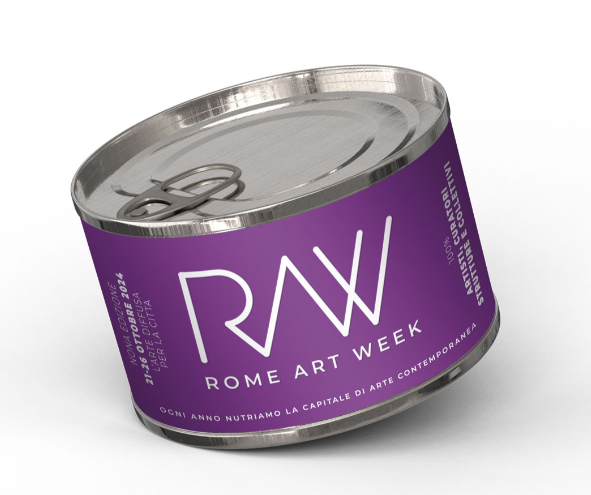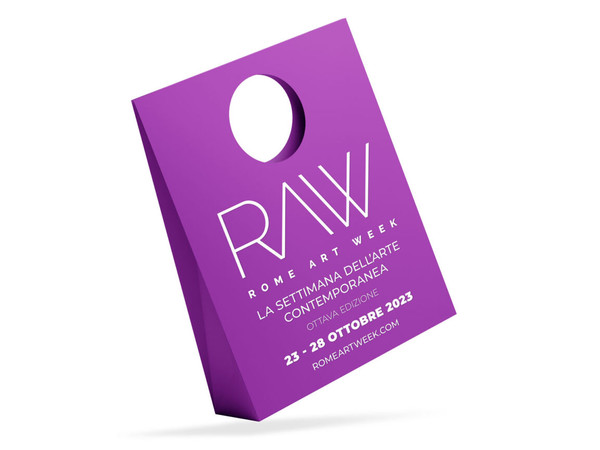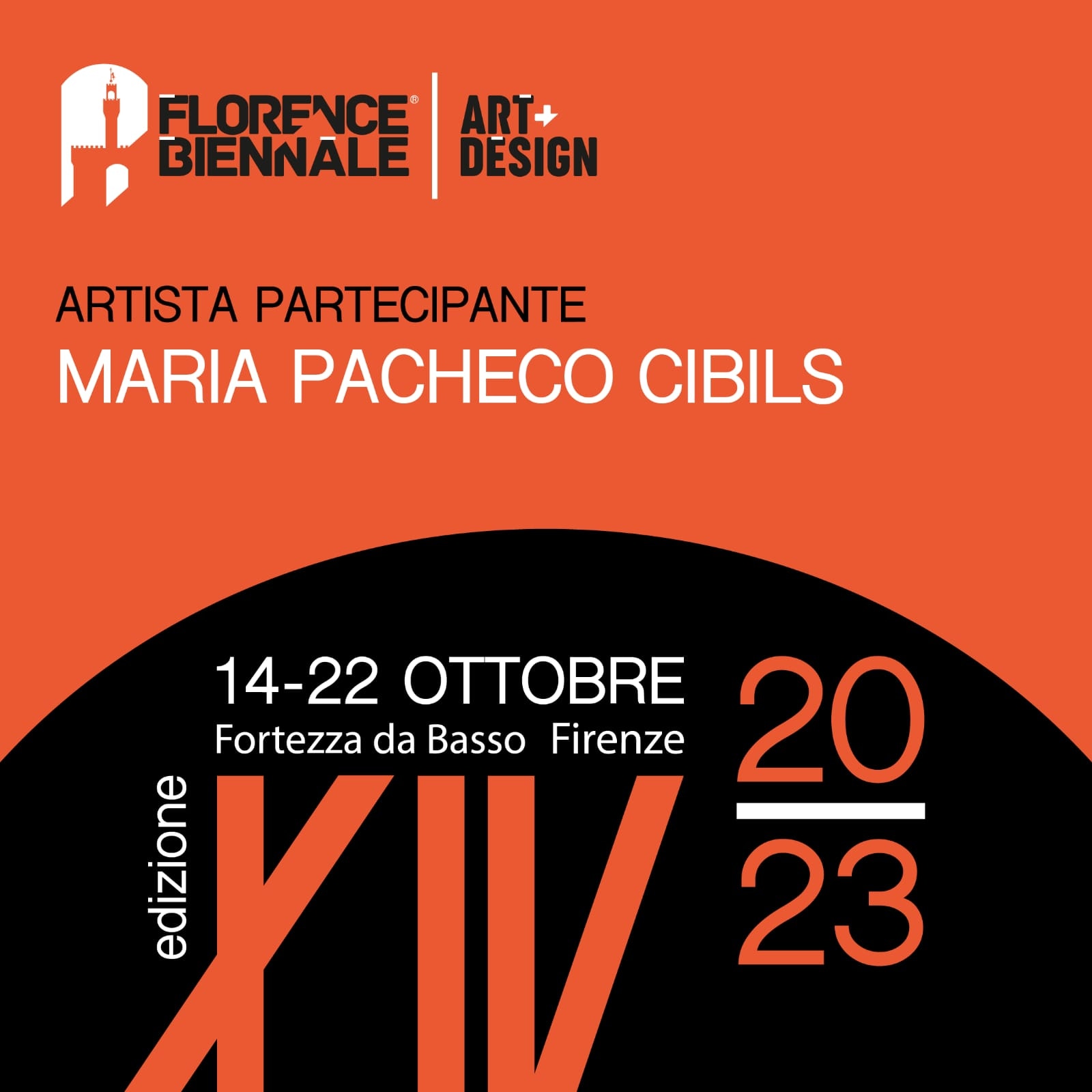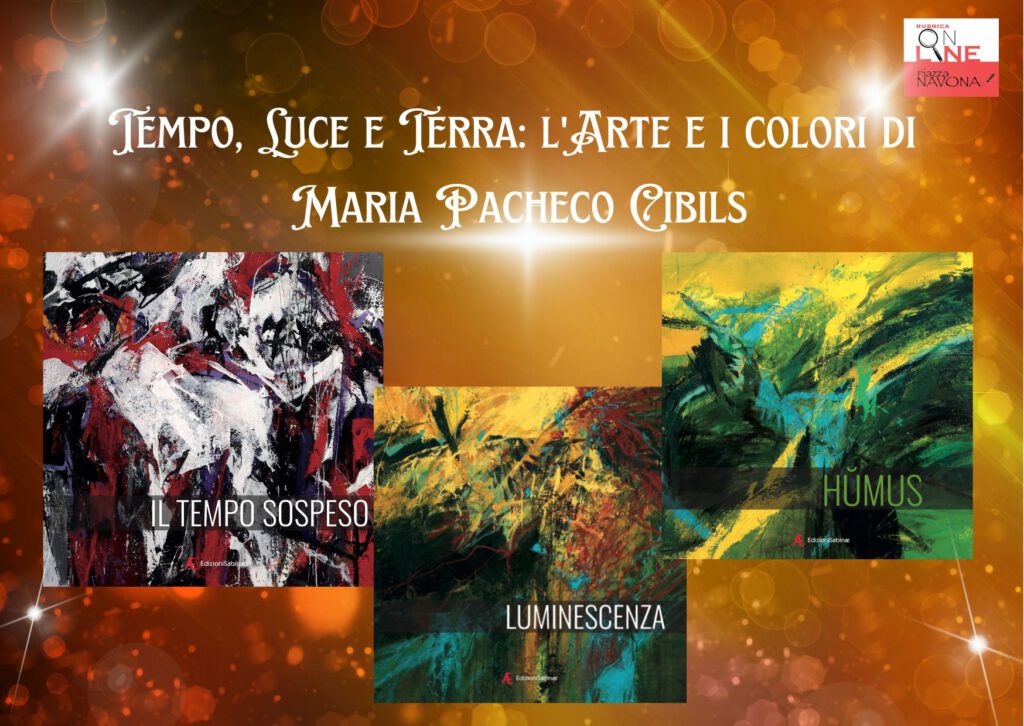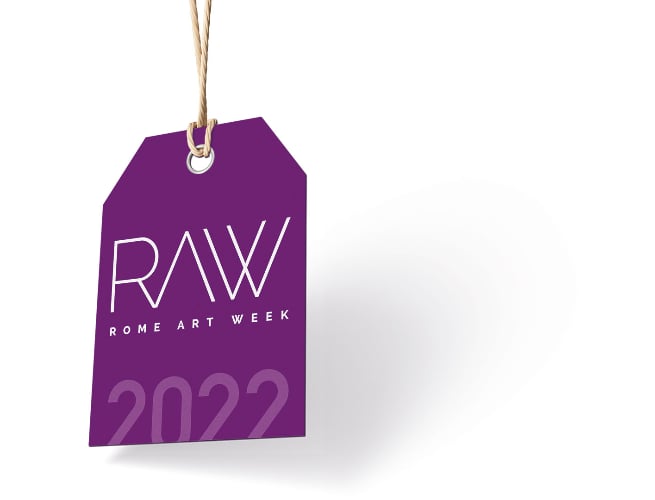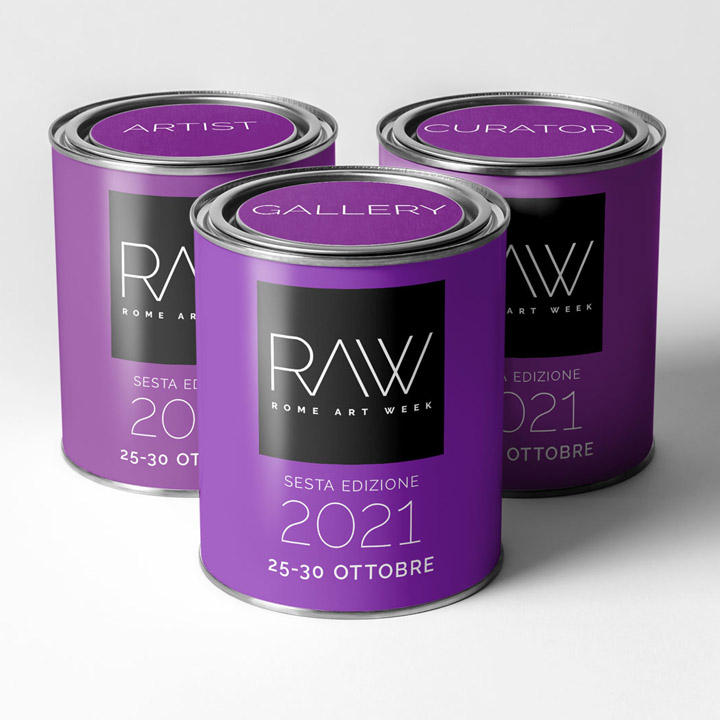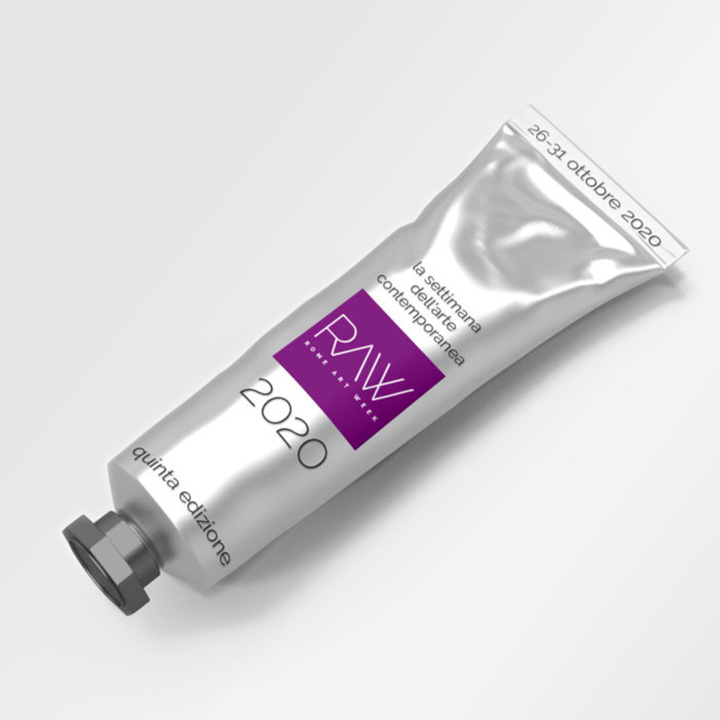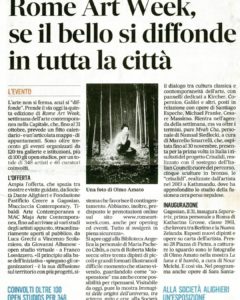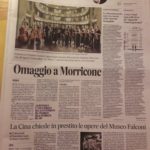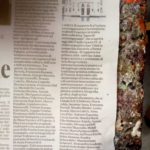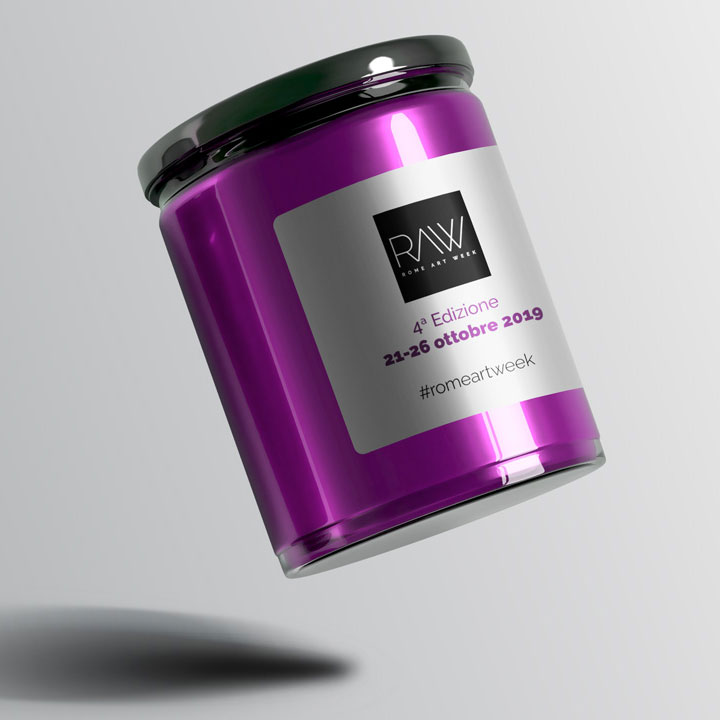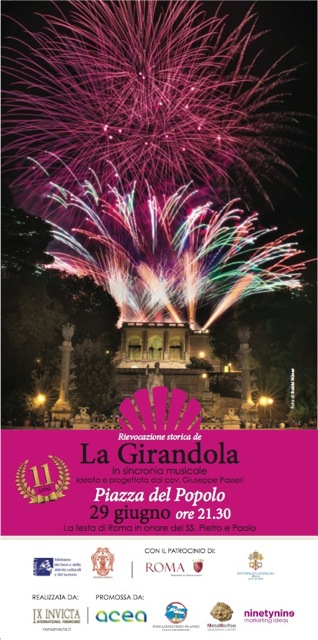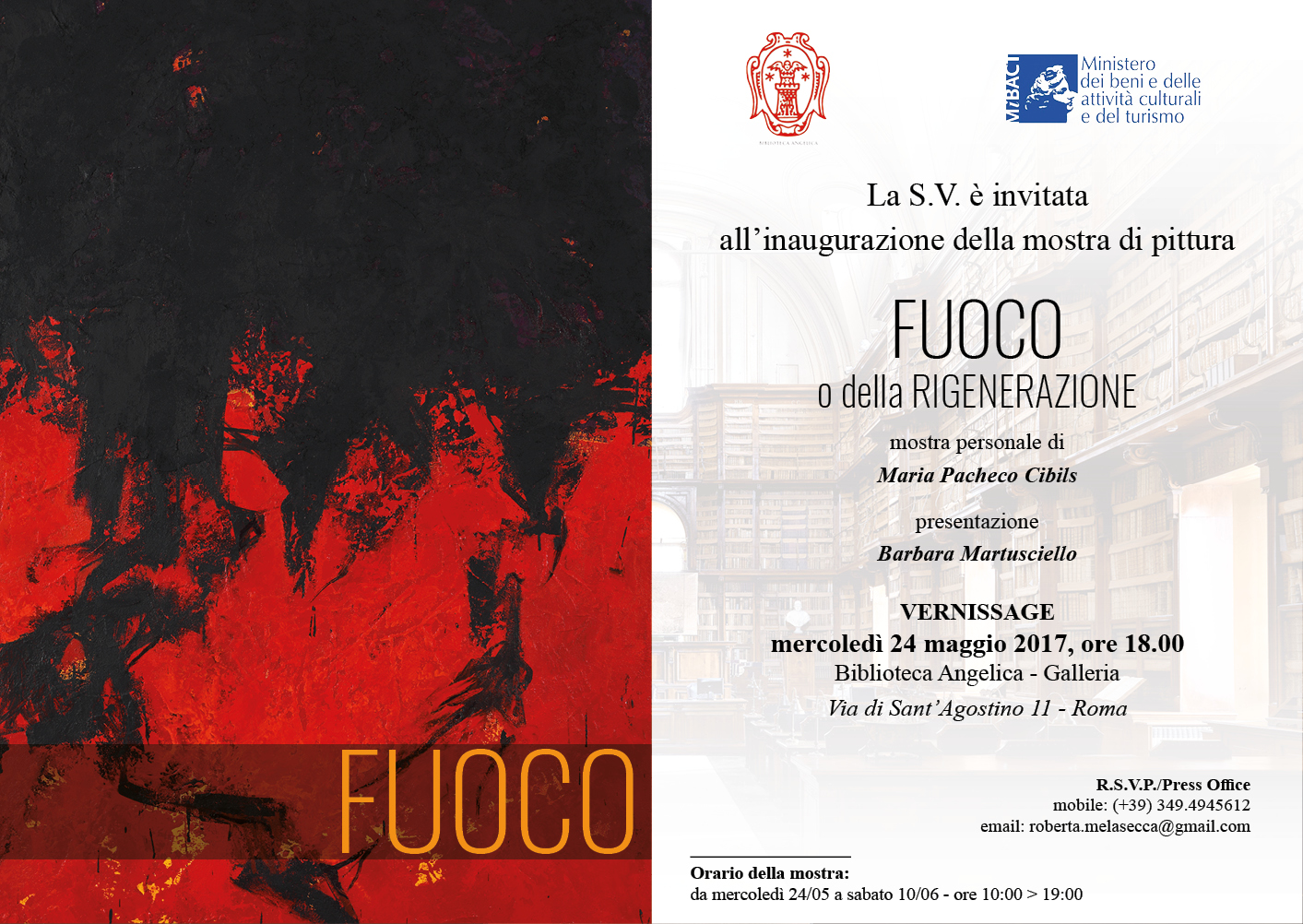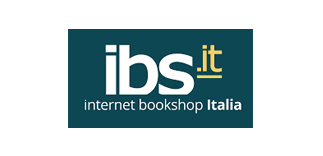Information and
Exhibitions
Below you can find a selection of texts related to my exhibitions and a series of links concerning Me and My Jobs available on the Internet.
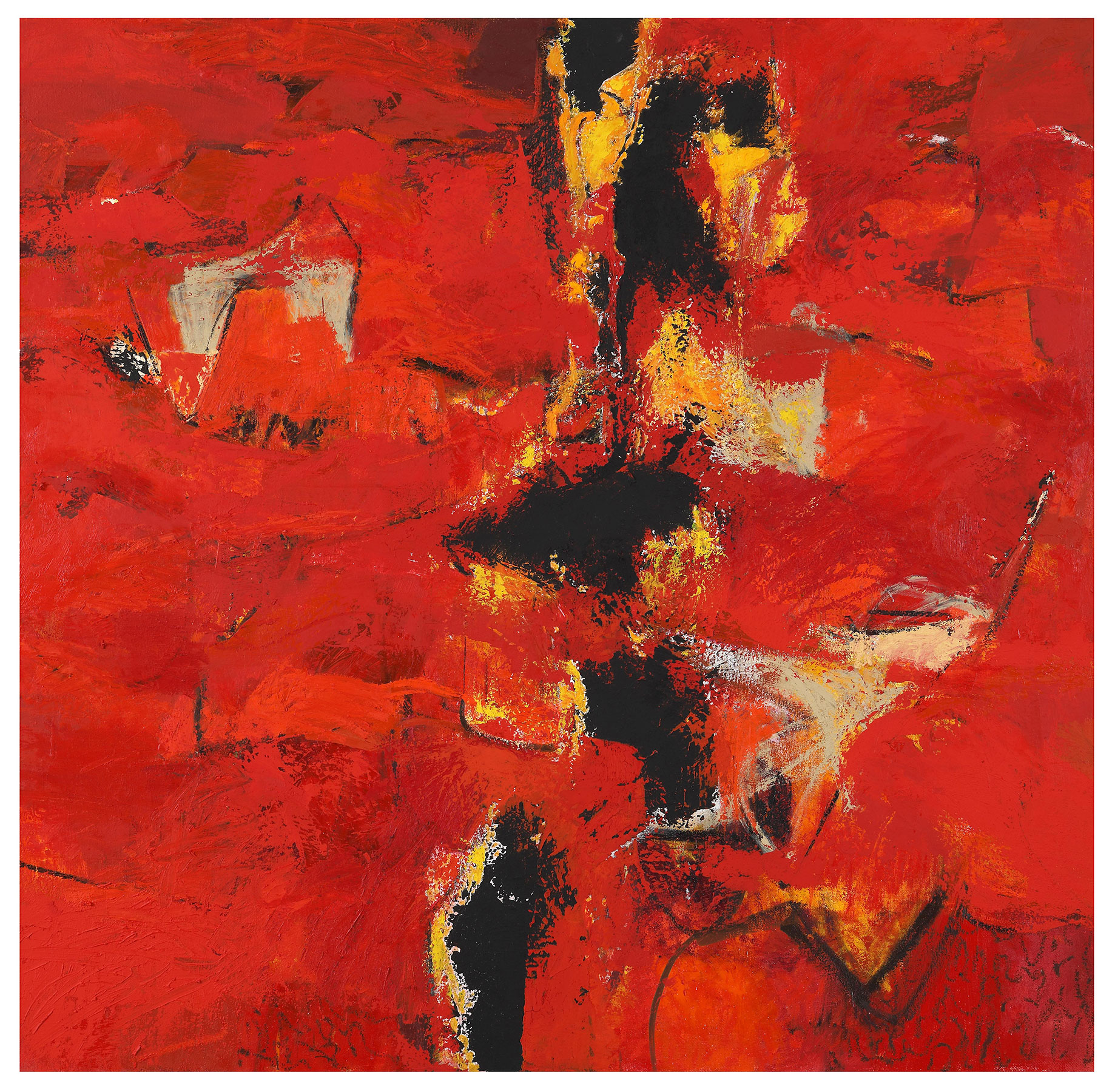
Rome Art Week 2024 – “I COLORI DEI SENTIMENTI”
Biblioteca Angelica – Roma
2024 Ottobre Roma 14/10 MOSTRA PERSONALE DI MARIA PACHECO CIBILS
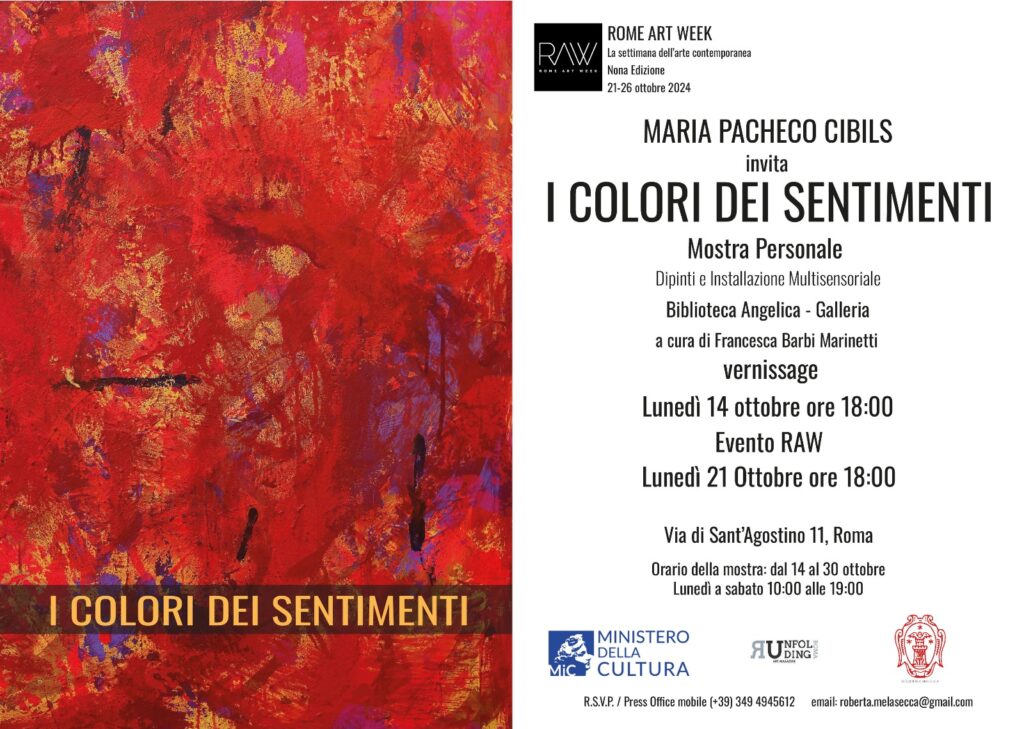 I COLORI DEI SENTIMENTI
I COLORI DEI SENTIMENTI
MOSTRA PERSONALE DI MARIA PACHECO CIBILS
A cura di Francesca Barbi Marinetti
THE COLORS OF FEELINGS / FEELING COLORS
We are connected by invisible lines. Our bodies all have a similar structure and are subject to the same external influences. Emotions and feelings continually invade our daily lives and they are the causes of our behaviors. Emotions, positive or negative, brief and intense, are the immediate response to a stimulus, they represent our most animal istinct.
They come into contact through certain energy fields of our body, stimulate associations, evoke primordial experiences, memories, and have the ability to awake feelings. The most lasting and nuanced feelings are develop through cognitive-affective processing. They are the roots of our way of being and throughout our existence, they show us the paths to follow and the goals to reach. First of all: love and desire, which are the driving forces of the individuals. Colors are often associated with emotions and feelings that can depend on cultures and personal experiences.
Nevertheless, there are some common and shared links. They carry a strong emotional charge and that, can be used to convey a wide range of feelings. They are a form of energy that acts as a vector. We find them where the action takes place, and they are truly capable of achieving unexpected results. In this exhibition I want to show works conceived as emotional portals, which want to represent feelings through primordial colors, and compose an immersive path capable of opening channels, connections between the visible world and the invisible inner world, thus leading the user on a path of rediscovery.
To know the symbolism of colors makes easier to communicate with ourselves and with others. Wavelengths without depth, without reality, colors transmit a subtle message.
They speak a language of light that have stimulated and still attract the interest of poets, philosophers, psychologists and artists. Their connection with emotions and feelings is undeniable and profound, as is their “magical” power, capable of the directly touching of the soul. Our feelings can change the world.
“We are helpless against feelings, because they simply exist and escape any censorship. We can reproach ourselves for a gesture, a phrase, but not for a feeling: we have no power over it”
Milan Kundera
“Exit the circle of time and enter the circle of Love”
Rumi
“In our lives there is only one color that gives meaning to art and to life itself: the color of love”
Marc Chagall
Maria Pacheco Cibils
PAINTING LOVE /by Francesca Barbi Marinetti
“The discourse of love is today of an extreme solitude”. This is how Roland Barthes began at the end of the Seventies, insisting that when a discourse is dragged into the drift of the untimely, expelled from every form of gregariousness, it has no other choice than to be the place, no matter how small, of an affirmation. An untimeliness that leads to an almost intractable nature. Perhaps this is why the pictorial rendering of this tremor – which everyone recognizes fundamental for life itself; the spark on which the reproduction of the species depends, but for which the ground of spontaneous cognitive sharing remains tenuous – was not easy for Maria Pacheco Cibils. Both in the choice of the theme and in the execution of the works, more than any other cycle she has previously tackled. The experimentation of the Argentine-Portuguese artist Pacheco Cibils has been moving for years in the direction of overcoming the traditional concept of form, with full-bodied and bright chromatic mixtures. They strives to offer an investigation of the energies that govern matter in an increasingly holistic conception of art.
The themes that inspire her they falls mainly within the sphere of ancestral and archetypal knowledge: the main elements of life, earth, fire, air and water in macro and microcosms, the founding dualisms of existence, such as light and dark or male and female. The cycle “The colours of feelings” includes 24 canvases of large, medium and small dimensions. They can be synthetically described as abstract and material, but the chromatic vigor, the texture, the rhythm and the depth that the pictorial matter assumes – which for the artist always refers to an explicit field of thematic research – recovers an unequivocal symbolism of colors. The same pictorial gesture, reiterated on multiple layers, tells in painting the complex journeys of the wave of amorous emotions.
The unbearable energy of the feeling that moves the sun and the other stars, the engine of creative inspiration since always and through all the artistic expressions of the world, fallen into disgrace from the second half of the twentieth century up to us, makes one uncomfortable both in sewing, or re-sewing, a separate discourse and in preparing to listen. Perhaps because love, among all feelings and ambitions, retains the power to revolutionize people’s point of view on crucial questions of life and, in a world where we are called to answer for ourselves by pigeonholing ourselves into defined roles and positions.
This uncontrollable power, which overturns and recreates, clearly exposes us to our human vulnerability. Barthes again, who tried to restore at least a semiotic order in contrast to the widespread tendency to remove the feeling, suggests a definition of these fragments of amorous discourse as figures. Figure not in a rhetorical sense, but in a gymnastic or choreographic one: that is, in the original sense of the Greek word σχῆµα (from which the concept of figure derives) which referred to a living meaning of the body caught in motion.
To the snapshot of a moment of energy in motion under stress. Just as Barthes indicates, for the linguistic figures that are composed under the guidance of the feeling of love, the pictorial gesture that intends to represent them draws inspiration from the deep trace that the vital energy of the feeling that leaves in each one of us. A necessary passage that involves no small amount of resistance and difficulty.
An almost Wordsworthian process that exposes the artist, also through empathy the observer, to ecstasy and torment, an emotion recollected in tranquillity that goes fishing in the intimacy and mysterious flow from which the fragility and strength of the most hidden sensitivity of each individual, branch out as. For the language, the discourse of love has a reference code that is topos, and as such, it retains in itself the peculiarity of being partly recognizable and partly vacant, empty, waiting to be filled. This void to be filled corresponds to the projective aspect, or what makes this topos partly recognizable and partly adaptable to the particular projections of each person.
The same happens for visual communication through the art of colors and shapes. The active principle – of the word, “lemma” or “phrase” as far as the language is concerned, or of the sign, matter, color for painting – is not so much what it expresses as what it manages to articulate and set in motion: that is, the throb that it produces in the suspension and expectation of the meaning that must necessarily be filled. Thus red, with all its possible shades, are commonly associated with love and passion, yellow and orange with brightness and energy, blue with depth, purple with mystery and green with hope. But it is the orchestration, the stratification, the material interpenetration of the pictorial plot that creates a succession of recognition and expectation, That all, goes fishing in the hidden caves of lit or extinguished fires, of expectations or disillusions, of surprising and instinctive wills or challenging fears and solitudes. Once these assumptions are accepted, it becomes clear that the pictorial representation of love can only indicate figures and cannot offer a complete and closed message.
The works are divided into more limited areas, such as passion, enthusiasm, hope, are touched here and there by brighter and more stimulating signs and colors, if not tormented and dark, but they all necessarily have as a common thread the expectation, which is the necessary dimension for the suspense of the encounter with who observes and completes. In other words, the discourse of love, neither in literature nor in painting, as in life, can ever be a soliloquy or an individual and subjective statement. It is not even dialectical. Rather, it presents itself as a manual user, a repertoire of possible imaginaries to draw from time to time according to different needs and sensitivities. Individual schemes break down when the feeling leads to wanting to resemble the other. Is the irrational condition in which we leave the furrow of our own convictions to look out renewed onto new scenarios.
And the driving force is not the success or failure of the objectives, but the energy and enchantment that can produce the bold ability to put ourselves back into play. A powerful energy that for some can also be implosive, despotic as well as irrational. A delirium, a roller coaster with peaks and precipices that produces adrenaline, or even fear, which in the end is not so extraordinary considering that it affects, once or more times in life, the majority of the human beings.
A regenerative resource to draw on even in abstinence from the natural doping of emotions, of which the memory remains, like a vibration of sound, especially if prompted by sensitive calls, such as art, literature or music, capable of reconnecting us with that fire-breathing dust that remains.
The works of Maria Pacheco Cibils are a cross-section of archetypal figures of love, each representative of that concentration of celebration, passion or bewilderment. Connecting, recognizing, relaunching is the due subjective homage that everyone is called to make, to complete a conversation, both interior and universal, that transcends and will always transcend every trend in history.
Francesca Barbi Marinetti
Art critic
THE COLOR OF FEELINGS / by Barbara Volpi
In the beginning everything is emotion, a sensory vibration that transforms in contact with the other in an intertwined emotional kaleidoscope, in which joy, fear, sadness, anger, disgust are mixed together to gradually unravel, touch after touch, caress after caress, in the loving embrace of someone who takes care of us and with his hands gives shape to our feelings. There would be no possibility of understanding the primordial language of emotions without the meeting of the hands each others, without the alchemical transformation that, from vital energy, passes to the others.
Like a diapson it broadens the emotional horizons and transforms them into affections and feelings. Everything passes and transforms into the warmth of the other who welcomes, makes the emotional language of the encounter theire own, and reshapes it into love, giving color to the vital harmony of the incessant and chaotic flow of time and times, passed before that sensory encounter. The Ego is shaped, in the psychoanalytic tradition, by that WE of bodies that meet and give transgenerational roots to the emotional experiences of each, transforming them into solid and deeprooted emotional bonds. From that WE are born many I’s and, many and many more WE’s, that open the way to the vibrations of a deep feeling of that vital love that supports and nourishes us and that is part of Mother Earth. The hands of the artist Maria Pacheco Cibilis have become a passionate and creative instrument to trace on the canvas the primordial language of the emotional encounter of bodies that welcome sensory experiences that are transformed by them.
Giving voice and chorus to the primitive feeling from which everything is born and that each of US can feel vibrating inside the soul: love. Each of US in a singular way, observing the canvases painted with the rhythm and cadence of a universal language, feels the notes of the many encounters of bodies that have transformed emotions into feelings resonate.
Each of US, with their own “pas de deux” sees them dance harmoniously following the vital rhythm that from love and passion for life finds incessantly flowing generativity giving shape and color to new, but at the same time archetypal, universal vital forms. Thanks truly again to the hands, the warmth and the energy of the artist for this explosive vital testimony that from creative expressions reaches the internal world of each, making us vibrate in unison Each with their own affective notes, in listening to that universal note that supports and gives universal foundation to all creative expressions: the LOVE
Barbara Volpi
Psychologist Psychotherapist University teacher Essayist
LOOK AT ART CONTEMPORARY ART EXHIBITION CENTRO CULTURALE DI MILANO
MILANO PROPOSTA ESPOSITIVA - MOSTRA EVENTO: 27 SETTEMBRE - 5 OTTOBRE 2024
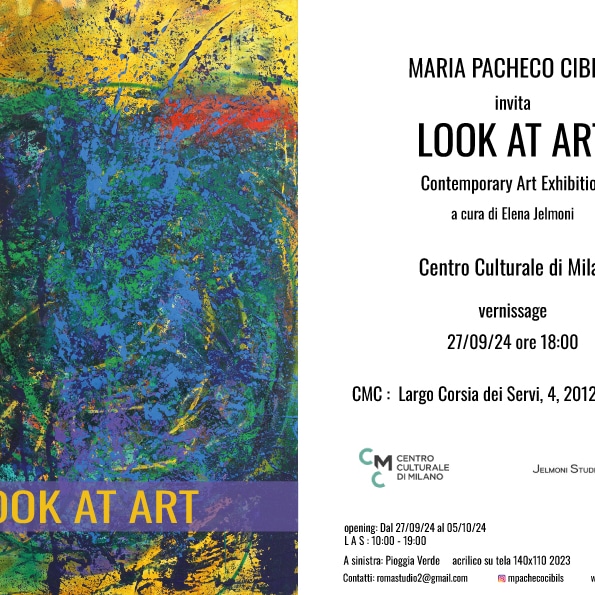
Comunicato stampa | Maria Pacheco Cibils in mostra a LOOK AT ART Contemporary Art Exhibition A cura di Elena Jelmoni
La designer e artista visiva argentino-portoghese Maria Pacheco Cibils sarà uno dei protagonisti di LOOK AT ART – Contemporary Art Exhibition, progetto promosso da Jelmoni Studio Gallery, a cura di Elena Jelmoni, che inaugura il giorno 27 settembre 2024 alle ore 18.00 presso il Centro Culturale di Milano.
L’arte si serve di un efficace linguaggio non verbale: l’azione, immediatamente comunicativa, i cui codici si sono sviluppati nel tempo e che impiega particolari strumenti per rendere manifesto il significato delle immagini rappresentate. Questa esperienza quotidiana dell’immagine vissuta genera orizzonti visivi e mentali in cui è possibile interrogarsi sulle funzioni passate e attuali dell’arte per riconsiderare il suo potere seduttivo e ruolo culturale.
Artisti provenienti da percorsi diversi e che utilizzano una pluralità di linguaggi espressivi affrontano queste tematiche in una serie di progetti individuali che si sviluppano come un percorso attraverso l’azione e la visione contemporanea.
Le opere nascono dalla combinazione sperimentale di elementi e linguaggi diversi alla ricerca del punto di incontro tra leggerezza e complessità da cui avventurarsi nell’esplorazione delle geografie psicologiche, politiche e sociali della cultura contemporanea globalizzata. L’arte è un pretesto per indagare concetti chiave del nostro presente, quali l’identità, nazionalità, la democrazia, il potere, la libertà, la partecipazione e i cambiamenti sociali.
Maria Pacheco Cibils presenta per l’occasione l’opera Pioggia Verde, appartenente all’ultima serie di lavori realizzati nel 2023. Come scrive la critica d’arte Francesca Barbi Marinetti: « Le opere di Maria ci trasportano in ambienti immaginari, e al contempo familiari, oltre una soglia che sfugge ogni definizione, in spazialità estese fatte di trasparenze, vortici cromatici, profondità, luminosità e straordinaria vitalità. Nella corrente dei paesaggi subacquei della pittura di Pacheco Cibils – in cui dominano i verdi, gli azzurri ed i blu con vortici o colonie vitali di arancioni, viola, gialli e rossi – l’osservatore è avvolto dalla suggestione di possibili scenari pre-mnemonici dei principi universali della vita che attendono d’essere recuperati. Pulsa un battito rigenerante che riconduce al pensiero orientale, in particolare il buddismo tantrico, per cui è la donna ad essere portatrice di energia cosmica e conoscenza.»
Maria Pacheco Cibils è designer e artista visiva argentino-portoghese. Le sue opere spaziano tra architettura d’interni, scenografie, ambientazioni, design di oggetti d’arte, pittura ed installazione. Ha collaborato con prestigiose riviste, giornali e canali televisivi. Ha organizzato mostre di artisti e fotografi, spettacoli di teatro e danza contemporanea. Curatrice di diversi brand, ha sviluppato prototipi e grafica degli stessi in Argentina, Paraguay e Italia. Le sue ricerche artistiche sono incentrate su temi primordiali e archetipici, indagando i quattro elementi della natura, radice di tutte le cose immutabili ed eterne e dei processi di trasformazione dell’essere umano. Ha partecipato a numerose mostre personali e collettive in Spagna, Germania, Austria, USA, Croazia, Regno Unito e Italia. Vincitrice del Primo Premio di Pittura “Lorenzo il Magnifico” a Florence Biennale 2023. Attualmente vive e lavora tra l’Italia e l’Argentina. Tra le ultime mostre: 2024 Roma “AROUND ROME” International Art Exhibition. Arte Borgo Gallery. Biblioteca Angelica Galleria. A cura di Anna Isopo; 2024 Nazzano “CHIAMATA ALLE ARTI”. Museo del Fiume. A cura di Guido D’Angelo; 2024 Barcellona “PROSPETTIVA….FUTURO” Hub / Art. International Art Exhibition; 2024 Londra “TRANSPARENT AS A DRAGONFLY”. Bermondsey Project Space; 2024 Firenze “I AM YOU” Accademia delle Arti del Disegno. Exhibition of the winner of the XIV Florence Biennale; 2023 Firenze “I AM YOU” “La Biennale di Firenze” Fortezza da Basso. Primo Premio Pittura: “LORENZO IL MAGNIFICO”; 2023 Roma”RITORNO AL BLU” RAW.Biblioteca Angelica-Galleria Mostra Personale; 2023 Roma “TRANSPARENT AS A DRAGONFLY” International Art Exhibition.Arte Borgo Gallery; 2023 Duvrobnik Croazia “COLOURS OF LIFE” Palazzo Sponza; 2023 Venezia“FRAGILITY UNVAILED” Palazzo Pisani Revedin Personal Exhibition; 2023 Roma “L’ATRA META’ DEL CIELO ”. Galleria La Nica; 2022 Spain PROJECT PALMA 1.0 Casa del Arte de Palma de Mallorca.Illes Balears. A cura de Artbox Project; 2022 Roma”HUMUS” RAW Biblioteca Angelica Mostra Personale; 2022 Milano “MULTITUDE” Fondazione Luciana Matalon Mostra Personale; 2022 Mantova “SYNESTHESIA” Museo Francesco Gonzaga; 2021 Miami Beach.Florida (USA) Scope Miami Beach International Contemporay Art Fair; 2021 Austria. Art Innsbruck.International Kunstmesse; 2021 Roma “LUMINESCENZA” RAW – Biblioteca Angelica – Galleria. Mostra Personale; 2021 Nazzano (Lazio) “EMPATIA NATURA COMUNITA” – Riserva Naturale Tevere Farfa, Nazzano; 2021 Roma “TRAME CONTEMPORANEE”- Palazzo della Cancelleria Vaticana; 2020 Roma “IL TEMPO SOSPESO ” RAW – Biblioteca Angelica – Galleria Mostra personale; 2019 Roma “DIMENSIONI PARALLELE”RAW Biblioteca Angelica .Salone Monumentale. Installazione; 2017 Roma “FUOCO ETERNITA SAPERE”.RAW:Biblioteca Angelica.Salone Monumentale. Installazione; 2017: Roma “FUOCO o della Rigenerazione” Biblioteca Angelica-Galleria. Mostra Personale.
Il Centro Culturale di Milano è nato nel 1981. Ai suoi inizi prese nome di “Centro Culturale San Carlo”, avendo la sua prima sede in corso Matteotti, presso la Basilica di San Carlo al Corso. Negli anni ’80 la sua storia è segnata da figure e incontri come quelle di don Luigi Giussani (che lo ha originato e seguito negli anni), lo scrittore Giovanni Testori, il vescovo Giacomo Biffi, lo scienziato Gian Paolo Bellini, il filosofo Augusto Del Noce, gli economisti Marco Martini e Gianfranco Senn, l’editore Sante Bagnoli. Da subito, grandi artisti, scienziati, filosofi, scrittori, dall’Italia e dal mondo hanno partecipato con entusiasmo a questo tentativo nuovo nella città, paragonandosi con questa novità culturale. Nei primi anni ’90 il nuovo nome: “Centro Culturale di Milano”, proprio mentre la città di Milano si ferma durante la crisi della politica ed emergono nuove sfide culturali e globali. La nuova sede è in via Zebedia 2, dove, secondo Dante Isella, si riunivano i circoli intellettuali di metà ‘800. Nel 2017, il Centro ristruttura, grazie a donazioni e a Fondazione Cariplo, il palazzo, disegnato da Caccia Dominoni, in Largo Corsia dei Servi 4, si avvia con il Comune di Milano una reciproca Convenzione per la Cultura e i suoi luoghi.
———————–
INTRODUZIONE AL PROGETTO
La centralità di Milano nel contesto europeo è un elemento preferenziale per l’assegnazione di progetti culturali che valorizzano il nostro patrimonio e rafforzano le collaborazioni. Milano, ambasciatrice dell’Italia nel mondo. Questa rete di relazioni si sovrappone all’area urbana ed ha la sua convergenza al centro, patrimonio di storia e fucina di futuro.
IL PROGETTO
L’arte si serve di un efficace linguaggio non verbale, l’azione, immediatamente comunicativa, i cui codici si sono sviluppati nel tempo e che impiega particolari strumenti per rendere manifesto il significato delle immagini rappresentate.
Questa esperienza quotidiana dell’immagine vissuta genera orizzonti visivi e mentali in cui è possibile interrogarsi sulle funzioni passate e attuali dell’arte per riconsiderare il suo potere seduttivo e ruolo culturale.
Artisti provenienti da percorsi diversi e che utilizzano una pluralità di linguaggi espressivi affrontano queste tematiche in una serie di progetti individuali che si sviluppano come un percorso attraverso l’azione e la visione contemporanea.
Le opere nascono dalla combinazione sperimentale di elementi e linguaggi diversi alla ricerca del punto di incontro tra leggerezza e complessità da cui avventurarsi nell’esplorazione delle geografie psicologiche, politiche e sociali della cultura contemporanea globalizzata. L’arte è un pretesto per indagare concetti chiave del nostro presente, quali l’identità, nazionalità, la democrazia, il potere, la libertà, la partecipazione e i cambiamenti sociali.
LOCATION – CENTRO CULTURALE DI MILANO
Un centro culturale, un luogo dove la passione per la verità e l’ascolto della bellezza uniscono gli uomini e la loro esperienza in un incontro permanente.
Il “Centro Culturale di Milano” è nato nel 1981. Ai suoi inizi prese nome di “Centro Culturale San Carlo”, avendo la sua prima sede in corso Matteotti, presso la Basilica di San Carlo al Corso. Negli anni ’80 la sua storia è segnata da figure e incontri come quelle di don Luigi Giussani (che lo ha originato e seguito negli anni), lo scrittore Giovanni Testori, il vescovo Giacomo Biffi, lo scienziato Gian Paolo Bellini, il filosofo Augusto Del Noce, gli economisti Marco Martini e Gianfranco Senn, l’editore Sante Bagnoli. Da subito, grandi artisti, scienziati, filosofi, scrittori, dall’Italia e dal mondo, hanno partecipato con entusiasmo a questo tentativo nuovo nella città, paragonandosi con questa novità culturale. Nei primi anni ’90 il nuovo nome: “Centro Culturale di Milano”, proprio mentre la città di Milano si ferma durante la crisi della politica ed emergono nuove sfide culturali e globali. La nuova sede è in via Zebedia 2, dove, secondo Dante Isella, si riunivano i circoli intellettuali di metà ‘800.
Nel 2017, il Centro ristruttura, grazie a donazioni e a Fondazione Cariplo, il palazzo, disegnato da Caccia Dominoni, in Largo Corsia dei Servi 4, si avvia con il Comune di Milano una reciproca Convenzione per la Cultura e i suoi luoghi.
IL CMC ALLARGA I SUOI CONFINI
Singoli, gruppi di persone che dal mondo si riconoscono e si mettono in relazione, passando da Milano. Nasce la riscoperta della storia della città passata, recente e nei suoi sviluppi prende vita, con Luca Doninelli, Camillo Fornasieri e Giuseppe Pontiggia, la Scuola di Scrittura Flannery O’Connor.
Si dedica uno spazio alla Poesia, si realizza l’incontro cercato e corrisposto col mondo ebraico, una profetica conoscenza e dialogo con l’Islam e della successiva “questione” islamica si indagano la storicità dei Vangeli e dei documenti cristiani, si presentano le Mostre internazionali di Fotografia attraverso l’edizione della collana “i Quaderni di Fotografia”, si intraprende il dialogo con i laici italiani ed europei, si discutono le questioni riguardanti il Diritto e la Democrazia.
Nel contempo si incrementano le partnership con istituzioni milanesi, Università, case editrici, teatri e il coordinamento con più di 100 Centri Culturali, in collaborazione con l’Associazione Italiana Centri Culturali, che ha sede presso il CMC.
Si snoda così quell’originale ricerca e incontro con i “grandi che ci sanno parlare”, rivolti a quei “piccoli che sanno ascoltare”, cercando di esserlo prima di tutto noi stessi. Mostre d’arte internazionali sono state realizzate al Centro Culturale Di Milano.
Jelmoni Studio Gallery
Rome Art Week 2023 – “RITORNO AL BLU” Biblioteca Angelica – Roma
2023 Ottobre Roma 24/10 “RITORNO AL BLU”
E
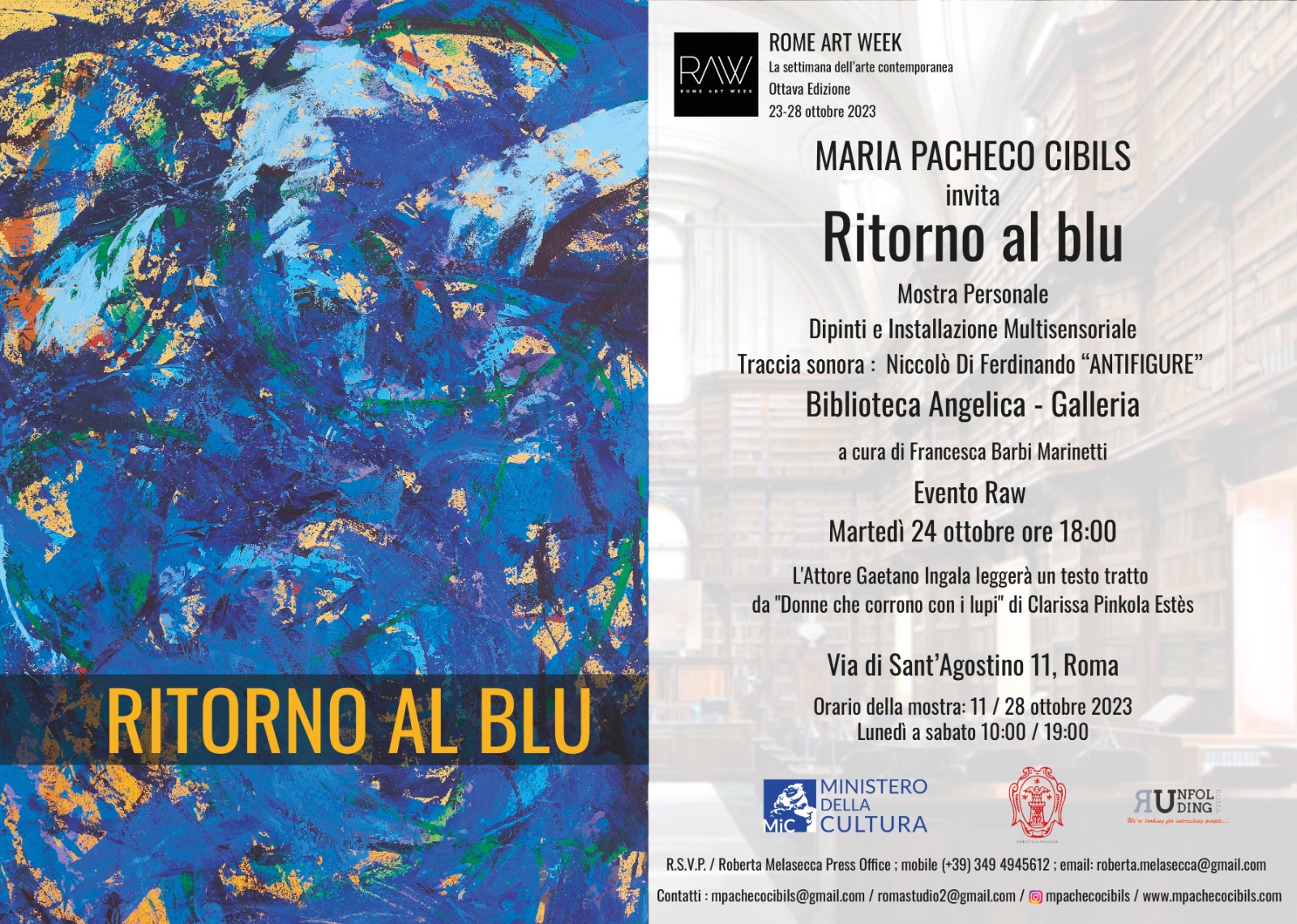
Comunicato stampa | Roberta Melasecca
Il giorno 11 ottobre 2023 alle ore 18.00 inaugura la mostra Ritorno al blu di Maria Pacheco Cibils, a cura di Francesca Barbi Marinetti, presso le sale della Galleria della Biblioteca Angelica (MiBACT), prestigioso spazio espositivo adibito alle
mostre di arte contemporanea.
In esposizione 18 opere pittoriche ed una installazione multisensoriale accompagnata dalla traccia sonora di Niccolò Di Ferdinando “Antifigure”. “Il ciclo pittorico presentato negli spazi espositivi della Biblioteca Angelica di Roma è dedicato all’elemento Acqua. Adattabile, fluida, ricettiva, l’acqua è un simbolo potente associato solitamente alla vita, alla rinascita, alla purificazione ed incarna il principio femminile sia per gli aspetti riguardanti la gestazione sia perché capace di trasformarsi continuamente penetrando e trasportando i nutrienti nel suolo e negli organismi. [ … ]
Le opere di questo ciclo ci trasportano in ambienti immaginari, e al contempo familiari, oltre una soglia che sfugge ogni definizione, in spazialità estese fatte di trasparenze, vortici cromatici, profondità, luminosità e straordinaria vitalità. La ricerca pittorica sembra spingersi in una zona che unisce valori simbolici a valori espressivi dinamici. Nulla è mai fermo, tutt’al più fluttuante. L’organizzazione della superficie è talvolta plurifocale. Un sommerso atemporale che sprigiona energia
e suggerisce la vastità della dimensione dell’inconscio a cui l’acqua in psicologia viene spesso associata.
È l’interiorità rimossa o dimenticata, l’utero materno come luogo protetto, la seduzione, l’amore, le profondità dei desideri celati, e la regressione, poiché l’acqua induce un rallentamento dei ritmi.
Nella corrente dei paesaggi subacquei della pittura di Pacheco Cibils – in cui dominano i verdi, gli azzurri ed i blu con vortici o colonie vitali di arancioni, viola, gialli e rossi – l’osservatore è avvolto dalla suggestione di possibili scenari pre-mnemonici dei principi universali della vita che attendono d’essere recuperati. Pulsa un battito rigenerante che riconduce al pensiero orientale, in particolare il buddismo tantrico, per cui è la donna ad essere portatrice di energia cosmica e conoscenza.”
(dal testo critico di Francesca Barbi Marinetti)
Maria Pacheco Cibils è designer e artista visiva argentino-portoghese. Le sue opere spaziano tra architettura d’interni, scenografie, ambientazioni, design di oggetti d’arte, pittura ed installazione. Ha collaborato con prestigiose riviste, giornali
e canali televisivi. Ha organizzato mostre di artisti e fotografi, spellaculi di lealru e darwi curilerriμura11ea. Curalrice di diversi brand, ha sviluppato prototipi e grafica degli stessi in Argentina, Paraguay e Italia. Attualmente vive e lavora tra
l’Italia e l’Argentina.
BACK TO BLU/ RETURN TO THE ESSENCE WATER. BLUE.FEMALE. MOON. MOTHER. GENERATING. REGENERATION. PURIFICATION. INITIATION. RECEPTIVITY. MUTABILITY. CYCLICITY.
“RITURN TO BLUE” is a story ot an inner journey towards our intimate and deep essence. lt is a call to pay attention to the power ot teminine energy, to value it, to honor its presence and make it a source ot wealth.
This energy has always been among us, sometimes recognized, loved and celebrated, at other times maligned, hidden and ignored, but it has always been present in Nature as in women, we just have to change the way we see things to capture its presence. Activating this different point ot view is a higher gear on the path ot evolution.
The feminine energy is related to wisdom, to the spiritual, to everything that escapes the physical world, it is archaic, wild, it has the primitive form ot Earth and Water.
The Earth is the great Mother, the concreteness ot women, her body, the fertility that she nourishes and sustains, the shelter, the caregiving, the one who keeps the seed in her bowels, in the darkness, in secret and in silence.
Water is the primary element, the origin ot lite.
lt is the amniotic fluid, the vastness ot the immersed and unfathomable ocean. lt is the tlow, the roundness, the flexibility, the vital and sensual emotion. lt is the unconscious and intuition.
By tinding our persona! dimension ot being a woman, we will accelerate our expansion and we will live each encounter in a more intense and conscious way.
Whether in a woman or in a man, regaining possession ot teminine energy also leads to the developing ot the masculine one, and vice versa. The two energies are intrinsically connected, the growth ot one promotes the other. This is in the nature ot things. lt is the duality that makes up the one. lt is the yin and the yang. The beginning ot the Tao. Balance and Harmony. Today, taking the element ot Water and the color blue, all its shades and in all its variants= indigo, ultramarine, cobalt,
sapphire, night blue, peacock, cerulean, Prussian, Egyptian, cyan, royal, turquoise or light blue, I want to show you the symbolism ot this sacred element and ot this energy that renews, releases, tertilizes, gives lite and abundance.
“Colour is a power that directly influences the soul”
Vassily Kandinski
Maria Pacheco Cibilis
RETURN TO BLUE by Francesca Barbi Marinetti
The large canvases by Maria Pacheco Cibils could be synthetically placed in the context of abstract and materiai art, created with different layers ot paint often mixed with other components tor the rendering ot organic textures or pictorial mixtures ot different density and body that assign greater depth and rhythm to the already intense chromatic vigor between light and shadow.
But more than the abstract, it would instead be appropriate to speak ot overcoming the traditional concept ot form, because the in-depth thematic analysis tor this Argentine-Portuguese artist, who has adopted our country as her second home, is decidedly nota pretext and this cannot escape the observer in any way.
In fact, aver the years, Pacheco Cibils has increasingly strengthened a holistic conception ot art through which to deepen and express a search tor truth and knowledge. Her paintings, delving into contents circumscribed on primordial and archetypal themes, mainly investigates the energy that spreads tram the materiai in which only apparently contrasting dualities interpenetrate= depths and heights, macrocosms and microcosms, light and dark, male and ternale, in constant dialogue with the elemental forces ot the world= earth, air, fire and water.
The pictorial cycle presented in the exhibition spaces of the Angelica Library in Rom e is dedicated to one element: Water. Adaptable, fluid, receptive, water is a powerful symbol usually associated with lite, rebirth, purification, and it embodies the feminine principle both in terms of gestation and capability of continuously transforming by penetrating and transporting nutrients into the soil and organisms. Foundation and substance of lite on a cosmic scale, water is the most precious of the elements, since without it there is no existence. Living beings are composed of water by more than seventy percent, and it is the first to leave the body when you die, with the vital breath.
The works in this cycle transport usto imaginary and at the same time familiar environments, beyond a threshold that escapes any detinition, into extended spaces made ot transparencies, chromatic vortexes, depth, luminosity, and extraordinary vitality. The pictorial research seems to go into an area that combines symbolic values with dynamic expressive values. Nothing is ever still, at most fluctuating. The organization of the surface is sometimes multifocal. A submerged timelessness that releases energy and suggests the vastness of the dimension of the unconscious to which water is often associated in psychology. lt is the removed or forgotten interiority, the materna! womb as a protected piace, seduction, love, the depths of hidden desires, and regression, since water induces a slowdown of rhythms.
In the current of the underwater landscapes ot Pacheco Cibils’ painting – in which greens and blues dominate with vortexes or vital colonies of orange, purple, yellow and red – the observer is enveloped by the suggestion ot possible pre-mnemonic scenarios ot the universal principles ot I ife waiting to be recovered. The work pulsates with a regenerating beat that leads back to Eastern thought, in particular tantric Buddhism, in which the woman is the bearer ot cosmic energy and knowledge.
In the symbolic and mythological imagery, water is perhaps the most present among the four elements because it is full ot meaning linked to the origin of lite and it is the one that penetrates nature in the most vital way. In the literary and religious fields, it has a connotation ot clarity and purifying properties and is at the same time mysterious and disturbing. lt assumes the tunction ot a mirror in the myth ot Narcissus, and is linked to the prophecy ot oracles, think of Delphi, Apollo or Rhodes, in which a revelation took piace through a fountain or a spring. The Moon is also related to it, as it regulates the flows of the tides and those of the feminine cycles, as well as influencing feelings and emotions.
The paintings of Pacheco Cibils are dynamic works that make one think of the principle of physics of the interconnection of matter which brought down the classica! concept of static partici es, demonstrating that subatomic partici es are the perpetually ongoing “process” rather than the stationary object. lt is in the Tao of Physics that fifty years ago Fritjof Capra explained how the fundamental principles of subatomic science had been anticipated by Eastern religious thought. An illuminating writing that with extraordinary balance united the history of mysticism and avant-garde scientific progress. Capra refers, in particular, to the principle of unity and mutuai interrelation of all things and all events, clarifying how it is presented as a process in which forms interact in dynamic configurations. The new physics announced that the polarities of classica! thought were overcome, an abstraction of the mind necessary far scientific evolution that should not be taken literally. This rigidity of approach, widespread in public opinion, was problematic both far the evolution of knowledge and far behavioral and relational habits, spreading
a tendency to highlight one or the other pale rather than think of them in correlation. Among these opposites, there is also the feminine and masculine of human nature, of which the Western tradition has favored the second, highlighting its aspects as more positive, such as activity,
rational thought, competitiveness, aggressiveness at the expense of intuitive modalities= mystical, psychic and introspective aspects, more associated with the feminine attitude. With destabilizing consequences, if we consider that far orientai thought achieving the dynamic balance between the feminine and masculine modality is the highest goal of meditation and that in the East, the need has been felt to represent this sublime interpenetration, since ancient times, in works of visual art.
Everything flows and fluctuates in water. The philosopher Gaston Bachelard argued that it is the element that best represents man tor its principi e of fluency: human lite flows like a river. This analogy to the passage of time has al so been compared to music, which in its infinite creative flexibility does not change its tempora! principle. Water itself produces a large quantity of sounds and, in turn, is sensitive to musical vibrations, it can perceive them by rippling. An ancient and evocative dialogue that Maria Pacheco Cibils wanted to represent here in an installati on with soundtrack by Niccolò di Ferdinando.
Francesca Barbi Marinetti
Art critic
ACQUA MATER: FEMALE SYMBOL THAT HOLDS UN IVERSAL EN ERGY / by Barbara Volpi
We were born in water, we are mainly composed of water and our deepest nature needs water to regenerate, purify, nourish and expand while remaining faithful to that primordial energy that has enveloped us since the dawn of time and continues to support the vita I flow that is, from the very beginning, intimately and exclusively feminine.
Always a symbol linked to the depth of the psyche, water is matter by constitution and from the abyss of the inner world, removed and forgotten, closed but generously open to the world, it expands outwards, with a propulsive jet, sometimes slow and intermittent, others incessantly constant and stili, others choreographic and bubbly, deeply vital ancestral elements that from the fluidity of the generating cavern are today captured by he decisive and instinctive gesture of the artist Maria Pacheco Cibilis, who has creatively redistributed them on the canvases giving the possibility to the observer to recognize parts emotionally deep and significant of oneself, of the other, of the individuai and of the community in that primordial fluid element that is part of us and that everyone seeks and researches, keeps or tries to reject, in the torrential flow of one·s own and others· existence. Emotionally warm parts, painfully frozen parts, cloudy jets, limpid flows, generating waters which, in the harmonious embrace of sensory totality, can be seen, touched, heard, tasted, smelled, and which in the emotional and instinctive reverberation of the vita I flow, of the powerful and radiant feminine energy, can incessantly nourish, preserve, cure and make the intimate essence of each of us germinate, giving an eternally vivid voice to that sigh of the anima mater which, from nature and its fluid primordial element, connects with its own vibrations and memories, to the universal rhythm of our life cycle, to that of the world and of the many other possible worlds.
Barbara Volpi
Psychologist
Psychotherapist
University teacher
Essayist
14-22 October 2023 Fortezza da Basso – Florence |XIV edition of Florence Biennale
14-22 October 2023 Fortezza da Basso - Florence |XIV edition of Florence Biennale
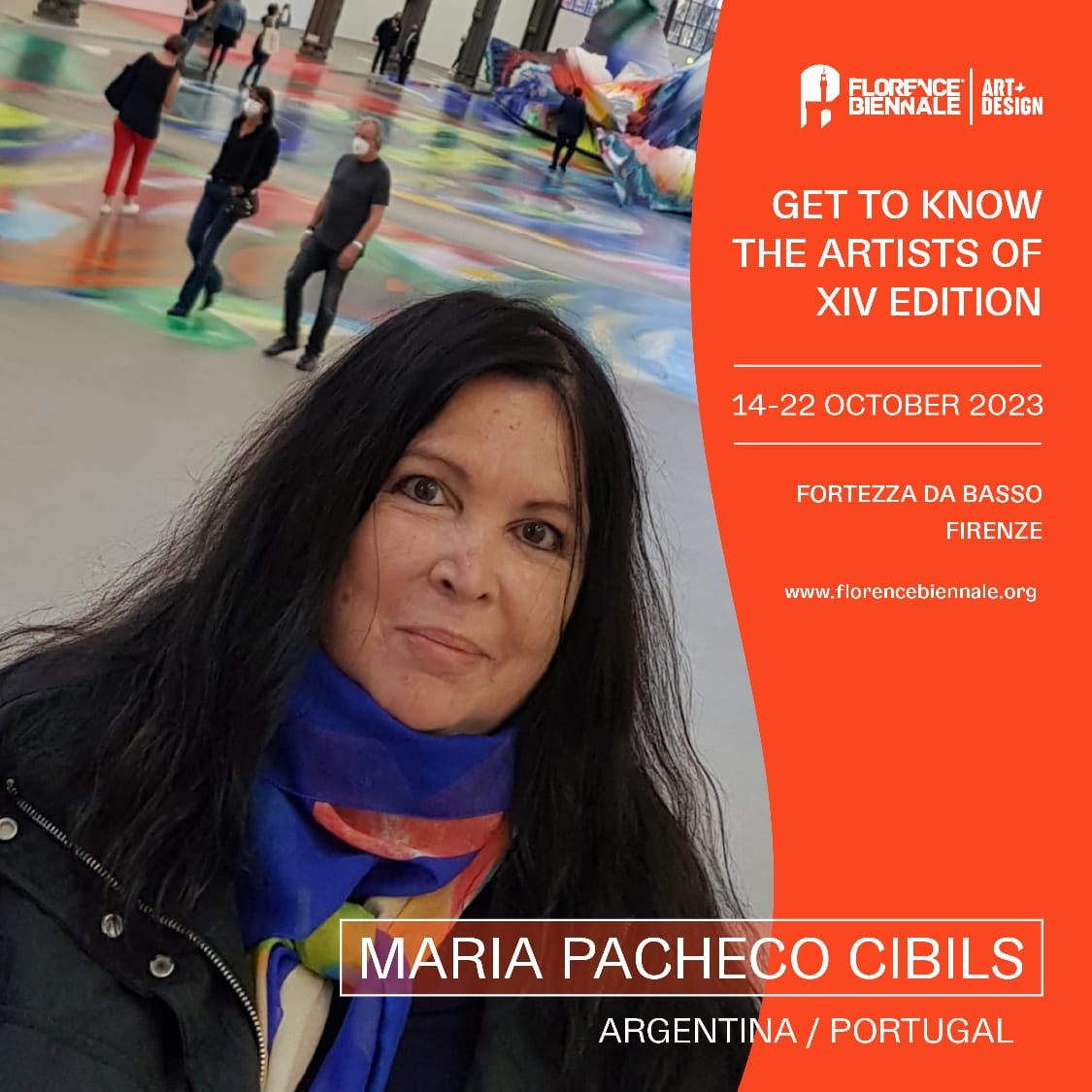
The Argentine-Portuguese designer and visual artist Maria Pacheco Cibils will be present at the XIV edition of Florence Biennale which will take place from 14 to 22 October 2023 at the Fortezza da Basso in Florence.
The event, centered on the theme “I Am You. Individual and Collective Identities in Contemporary Art and Design” which aims to explore the concepts of individual and collective identities, in their many philosophical, psychological, sociological and cultural meanings, expects the participation of over 550 between artists and designers, and will be enlivened by special projects, awards and important international presences.
Maria Pacheco Cibils presents four works belonging to her latest exhibition project, Humus, inaugurated in 2022 during Rome art Week in the prestigious space of the Angelica Library Gallery in Rome. With Humus, the artist continues her reflection on the natural elements and on the relationship with the ecosystem, declaring a feeling that evokes the attachment to mother earth and which emerges overwhelmingly in the pictorial process where passionate feelings are generated to return existing criticalities to observation (cited by Maila Buglioni). The four works, from the Espansione and Selva cycles, describe a multisensory space full of energy in continuous movement, where it’s possible to recover a secret, ancestral breath, materialized in the guise of forests with bluish shadows, shelters with a subtle underground texture that expand and they regenerate with new life. Maria’s research, focused on the processes of transformation of the human being, exudes power and chromatic energy, comes alive with material vibrations and organic textures, stratified, clear and dynamic color densities.
Maria Pacheco Cibils is an Argentine-Portuguese designer and visual artist. Her works range from interior architecture, scenography, settings, design of art objects, painting and installation. She has collaborated with prestigious magazines, newspapers and television channels. She has organized exhibitions of artists and photographers, theater and contemporary dance performances. Curator of several brands, she has developed prototypes and graphics of the same in Argentina, Paraguay and Italy. She currently lives and works between Italy and Argentina.
Download the press review in PDF
2023 Ottobre Roma 05/10 al 18/10 “TRANSPARENT AS A DRAGONFLY” .International Art Exhibition.Arte Borgo Gallery
TRANSPARENT AS A DRAGONFLY International Art Exhibition Arte Borgo Gallery A cura di Anna Isopo Rita Carta Manias Lesley Bunch Martina Scavone
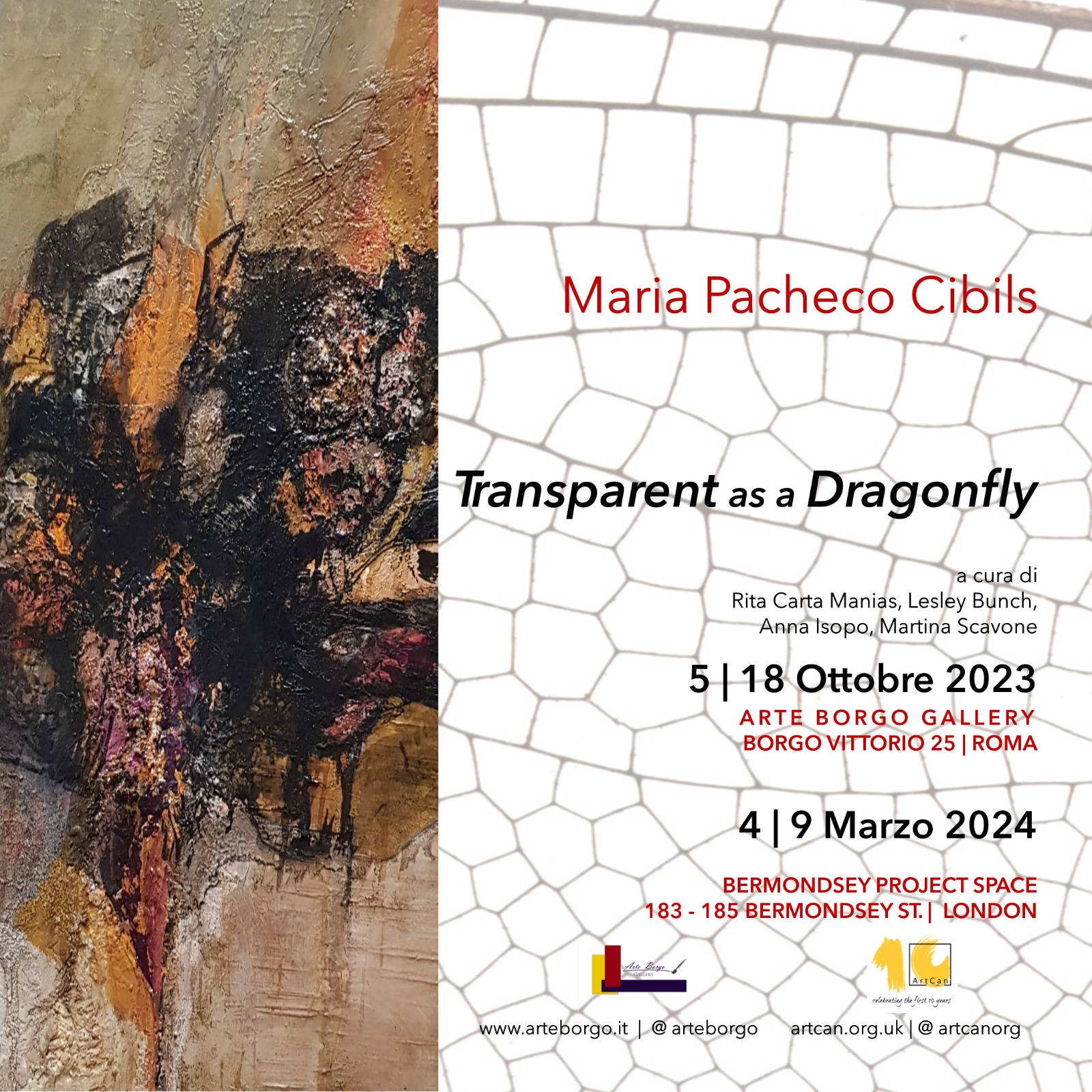
CURATORS’ FOREWORDS
ANNA ISOPO
Celebrating the author of “lnvisible Cities” is the aim of the exhibition “Transparent as a Dragonfly”, conceived of as a recognition to Italo Calvino on the centenary of his birth. The exhibition was born out of the collaboration between the Arte Borgo Gallery and Art can, placing the expressive language of the artists at the forefront, influenced by one of the author’s most significant texts, “lnvisible Cities”.
An exhibition that will move beyond ltalian borders, firstly presented in the Arte Borgo Gallery exhibition space in Rome, then travelling to the Bermondsey Project Space in London, brings together the work of 36 artists united by linguistic interweavings whose rote is comparable to the rote of the reader of a novel who, addressing various issues, focuses on complex productions and reflections permeated by an intimate investigation from which one’s personal creativity emerges. United by a similar introspection on places, people and memory, the artists create a harmonious dialogue between space and works. An exhibition that celebrates a masterful coexistence through the pages of the book and the works of the artists
MARTINA SCAVONE
Art historian
Transparent as a Dragonfly is an exhibition that fully reflects the book from which it is drawn, “lnvisible Cities” by Italo Calvino; eclectic, refined, pulsating with energy and creativity. Vision and dreams are the pillars of the story, which over fifty years later continues to inspire subsequent generations.
“You take delight not in a city’s seven or seventy wonders, but in an answer it gives to a question of yours”. Precisely starting from Calvino’s descriptions and quotes, the international artists selected for the event have translated the cities built with the writer’s words into visual form, cities that often look like living characters, with a beating heart, whose internal and external characteristics are the result of experience gained aver the years. “lnvisible Cities” themselves were not born in one fell swoop but “one piece at a time”, as stated by their author. The same principle applies in fact to a work of art, which is the result of stimuli, thoughts, memories, reflections and feelings that move from a completely personal experience and path of knowledge, within which the observer can reflect himself or choose to get lost, just like when visiting a new city.
The aim of the exhibition is therefore to recreate the unusual dynamics that govern the places described by Marco Polo to Kublai Khan: tales of cities that, through the imaginative process, lead to the creation of a single, great work of art. The link created between the book and the artistic language therefore becomes explicit and significant, demonstrating the fact that words and images, fused together, create a network of connections and sharing that goes beyond geographical, social and artistic boundaries, making palpable and clearly visible what is often invisible to the eye.
“Art does not reproduce the visible but makes it visible.” Paul Klee
LESLEY BUNCH ANO RITA CARTA MANIAS
In celebration of 100 years since ltalian author Italo Calvino’s birth which takes piace on the 15th of October 2023, the exhibition ‘Transparent as a Dragonfly’ is based on artists’ responses to his book, ‘lnvisible Cities’,
(1972). The title for the exhibition has been taken from a passage in Calvino’s lnvisible Cities: “Perhaps everything lies in knowing what words to speak, what actions to perform, and in what arder and rhythm; or else someone’s gaze, answer, gesture is enough; it is enough for someone to do something for the sheer pleasure of doing it, and for his pleasure to become the pleasure of others: at that moment, ali spaces change, ali heights, distances; the city is transfigured, becomes crystalline, transparent as a dragonfly” Calvino, lnvisible Cities, (1972).
We asked that artists choose a line, passage or chapter from the book, and propose either existing work which explores a related concept, or new work made in response to it. Responses were varied, encompassing concepts including the power and limits of language, the relationship between language and things, memory, perception and piace.
Calvino was offered the 1985-86 term of the Norton Professorship of Poetry at Harvard. He died just weeks befare he was scheduled to depart, however his lecture notes were later published in 1988 as “Six Memos far the Next Millennium”. In these manuscripts he looked back at the ‘millennium of the book’, and forward to what the future might hold for the ‘expressive, cognitive, and imaginative possibilities’ of language and literature. “My working method has more often than not involved the subtraction of weight. I have tried to remove weight, sometimes from people, sometimes from heavenly bodies, sometimes from cities; above alt I have tried to remove weight from the structure of stories and from language … l have come to consider lightness a value rather than a defect”
2023: Settembre. Dubrovnik “Colours of life” 29/09– 09/10 Palazzo Sponza
2023: “Colours of life” 29 settembre – 09 ottobre 2023 Palazzo Sponza – Dubrovnik
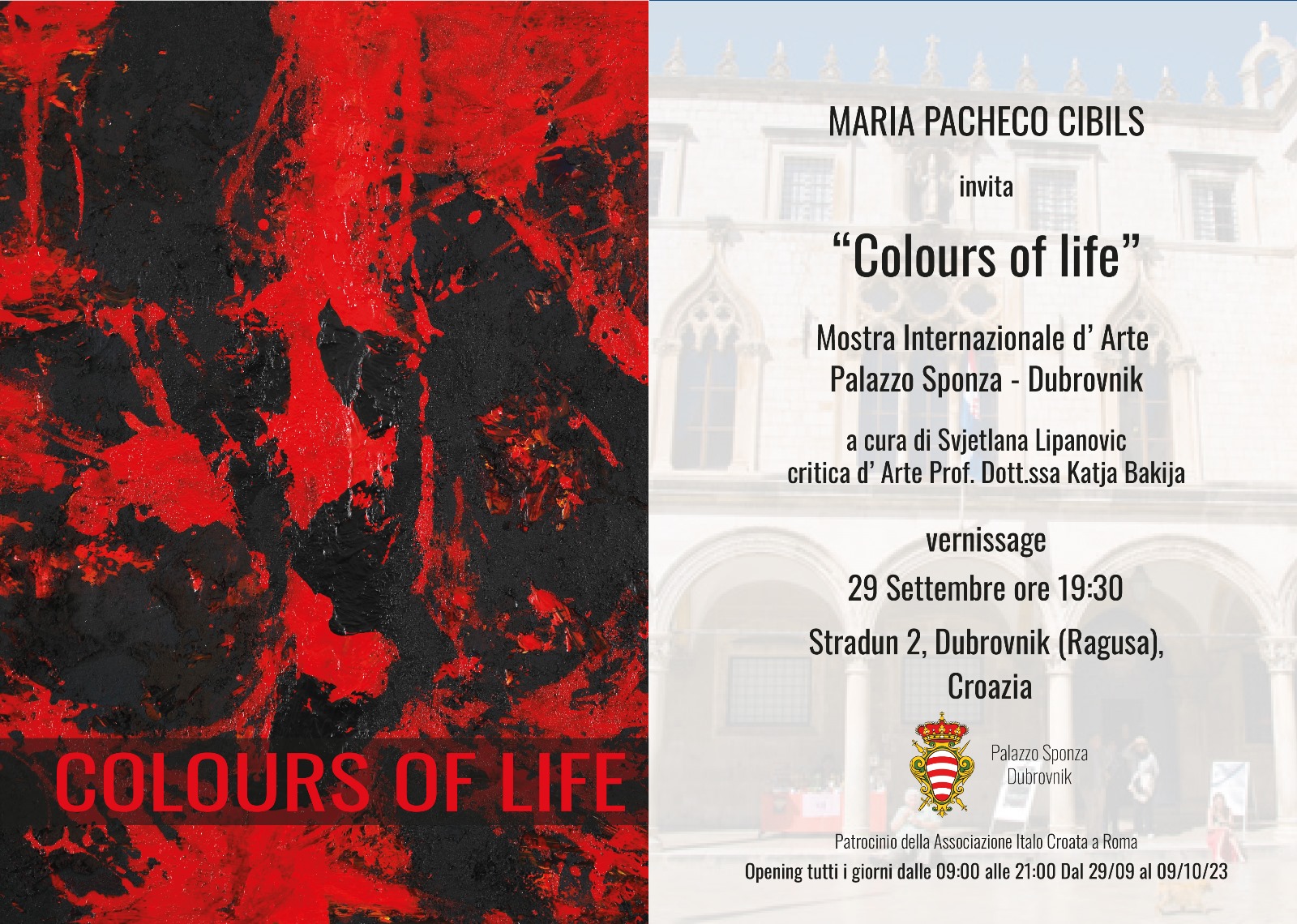
di SvjetlanaLipanović
La mostra internazionale “Colours of life” è stata inaugurata il 29 settembre 2023 nell’atrio magnifico del Palazzo Sponza a Dubrovnik in Croazia. SvjetlanaLipanović, presidente dell’Associazione Italo-Croata di Roma ha organizzato la mostra, sotto il patrocinio anche dell’Associazione. Al pubblico raguseo si sono presentati gli artisti croati, italiani, argentini, svizzeri: Bruno Bulaja, StankoIvanković, MargaretaKrstić, Ante Milas, Maria PachecoCibils, Daniela Rebuzzi, Stipe Renić, VeronikaŠulić, Ivana JovanovićTrostmann. Il signor Stipe Renić ha esposto la sua collezione privata e così, si sono potute ammirare le opere di: Ivan Meštrović, FranjoKršinić, Vasilije Josip Jordan, EmanuelVidović, SofijaNaletilićPenavuša e di Maria Teresa Sartori, pittrice italiana. La Prof.ssa Katja Bakija, critico d’arte eSvjetlanaLipanovićhanno inaugurato la mostra davanti vari visitatori. Nel Catalogo,la Lipanovićha evidenziato che: “sotto il segno dell’arte i percorsi degli artisti nel campo della pittura e della scultura sono immortalati con le numerose opere di grande suggestione con le quali hanno raccontato con le immagini il complesso mondo contemporaneo. Il detto del grande pittore Salvador Dali perfettamente definisce l’impostazione della mostra perché afferma che “ non è l’importante la realtà delle cose, ma come le vediamo noi e che cosa rappresentano per noi”. Di conseguenza, le opere esposte hanno rappresentato varie visioni della realtà, spesso trasformata nel modo come ogni artista la percepisce. In seguito a tale metamorfosi gli amanti dell’arte visitando la mostra hanno trovato diverse scene del quotidiano, a volte dipinto in modo realistico, disegnato con segni astratti del cromatismo affascinante dove l’interpretazione diventa molto soggettiva, immaginato come un sogno a occhi aperti con il gioco delle tonalità contrastanti, oppure inciso nel legno e realizzato in bronzo. L’arte è da sempre un formidabile mezzo per raccontare la bellezza ma anche le verità spesso difficili da esprimere tramite il linguaggio.
“Colours of life” oppure “ Colori della vita” hanno brillato fino al 9 ottobre nelle sale assolate del palazzo rinascimentale; le opere sono state viste dai numerosi avventori che hanno apprezzato l’impostazione interessante della mostra pubblicizzata presso la stampa croata, la radio e la TV di Dubrovnik ed anche nella stampa italiana, tedesca, su web dell’Associazione Italo-Croata e su Internet.
2023: Marzo. Venezia 08/03 al 19/03. “FRAGILITY UNVAILED” Palazzo Pisani Revedin
2023: Marzo. Venezia 08/03 al 19/03. “FRAGILITY UNVAILED” Palazzo Pisani Revedin Personal exhibition. A cura di Anna Isopo.
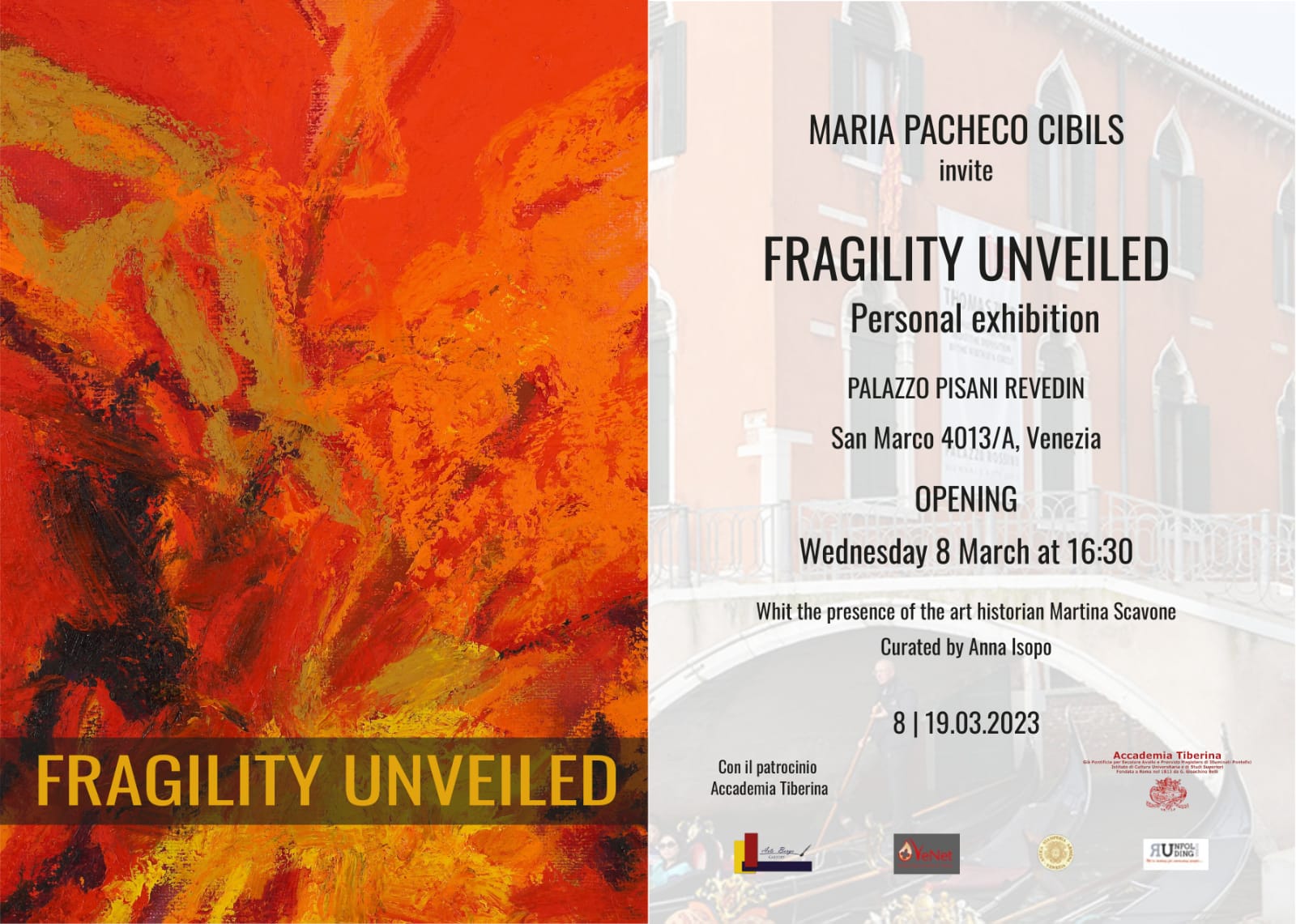
The “Unveiled fragility” Exhibition Project the intention Is to convey a message of hope far a humanity free to express its desire far lightness, without fear of showing its frailti;JPainting, scÙlpture and installations declined in different shades, languages ahd techniques will integrate with the excellence of the exhibÌtior\ venue, connected by a transparent thread thatalso unites the user, artists and spaces, with the aim of giving voice to the concepts evoked by the artworks and that are destined to echo forever.
Maria Pacheco Cibils is an intense and passionate artist, creator of a rather unique production of its kind, in which she inaugurates a reflection on natural elements and on the man-ecosystem relationship. In this exhibition, in particular, she presents a series of large-format works inspired by Fire, a symbol of profound strength as well as the engine of the periodic regeneration of Nature. The primary and life-giving element par excellence, Maria Pacheco Cibils’ Fire is expressed in decisive shades, essentially limited to bright red and black, rendered in the form of a materiai plasticity that thickens on the support, transmitting an intense perceptive emotion.
Such chromatic nuances inevitably suggest a reference to primordial energy, to the incandescent heart of the Earth, which gives Pacheco’s creations a delicate aspect like flesh but at the same time strong like rock, thus arousing a great emotional impact in the observer.
Nature and lite emerge with extreme purity from the pictorial surface, like an eternai and indestructible flame, giving the user a cathartic experience in which to succumb and be reborn like the phoenix which, after being burned, rises bold and powerful from its own ashes. In Pacheco’s production we can therefore grasp a message of resilience and profound vitality, something really similar to the concept of Roman virtus, intended as a statement of conscious strength and perseverance.
Martina Scavane
Art historian
Rome Art Week 2022 – “HŬMUS”
Biblioteca Angelica – Roma
HŬMUS Mostra Personale di Maria Pacheco Cibils A cura di Maila Buglioni
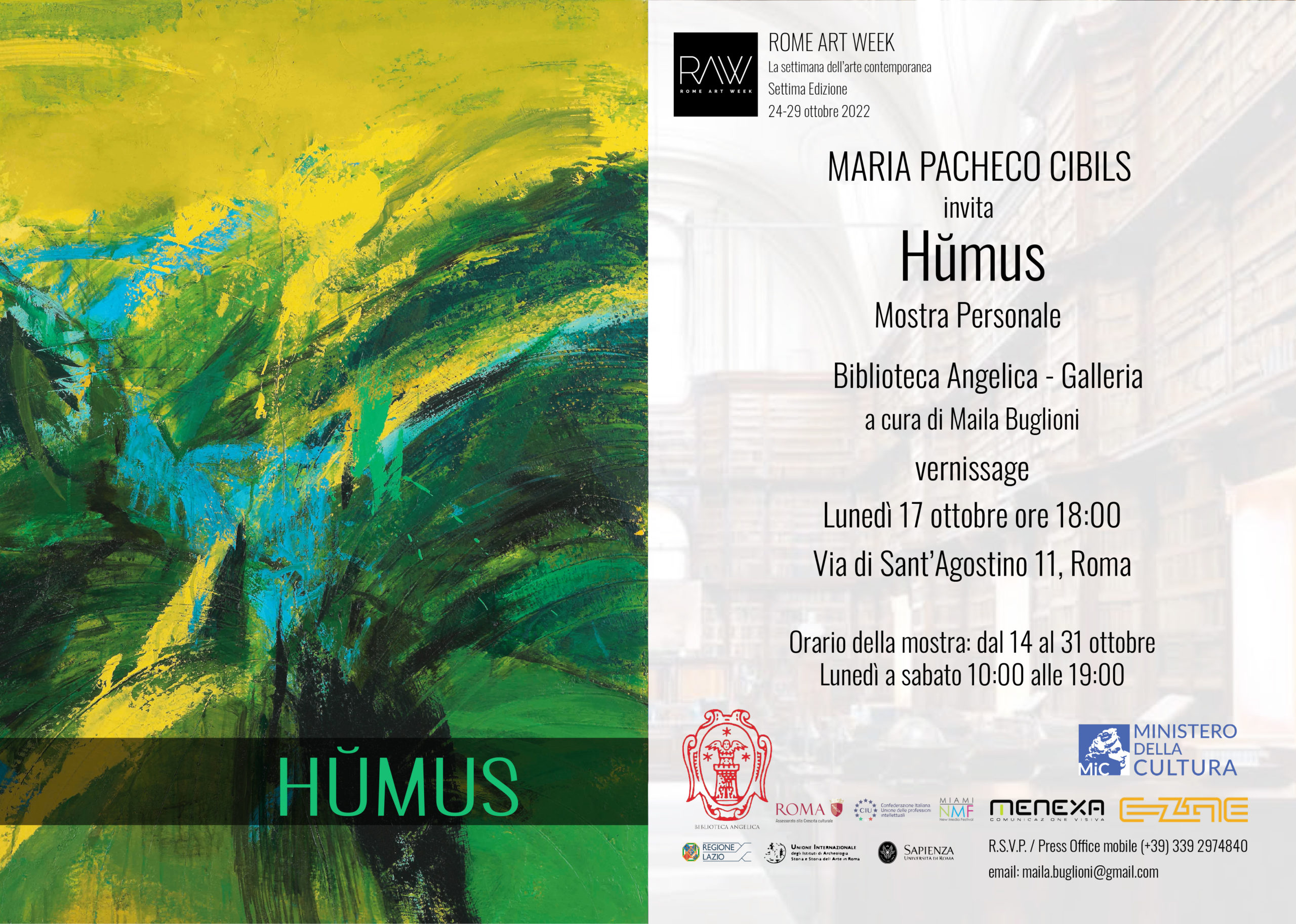
Hŭmus
Breath of the universe
The exhibition consists of
17 large and medium format paintings and a multi-sensory installation.
Collaboration in audio and editing by Niccolò Di Ferdinando ( ANTIFIGURE )
Project: Maria Pacheco Cibils
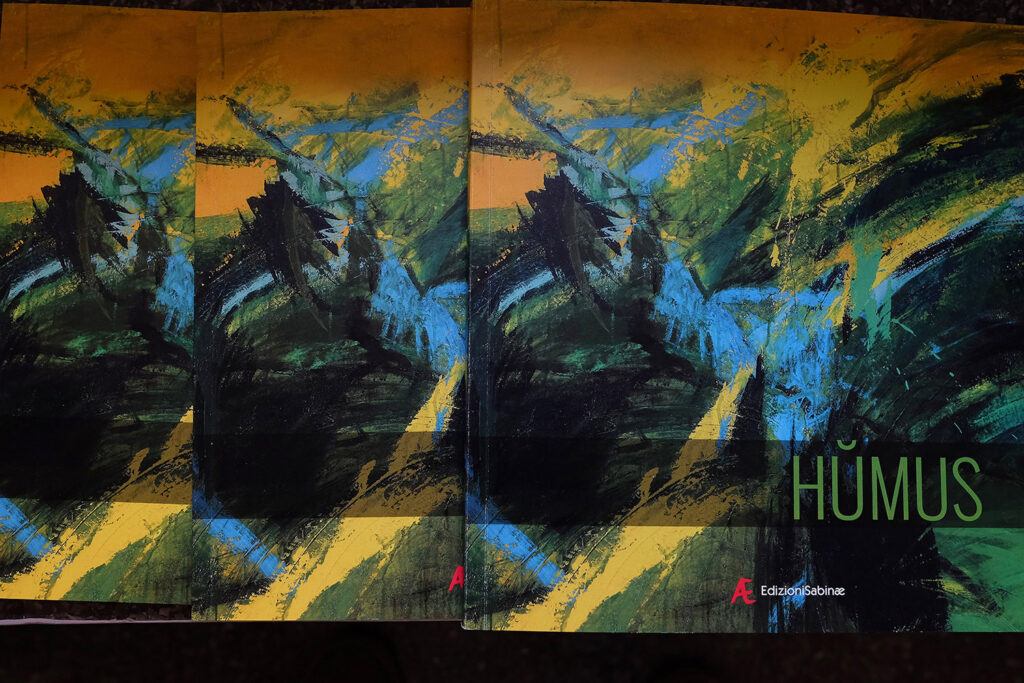
HŬMUS: (Medieval Latin) Land / Soil / Land / Soil / Country
Deep sediment that allows the passage to life.
Subtle and underground texture that favors fecundity, fertility and creation.
Essential element for existence.
Soul, spirit, heart and lung of the world.
Refuge, open space, great mother, matter, lifeblood, oxygen, breath…
Regeneration, renewal.
Secret, ancestral breath, green humidity, bluish shadow forest, foliage, nature
expanding where the filtering reflections shine in the eyes.
Hints and scents, sounds and colors; a sensory journey full of energy in
continuous movement… immense “green hand” that becomes for Michel Pastoureau
symbol of destiny, hope, nature and freedom.
Taking care of the natural environment means taking care, receiving care.
Protecting this precious heritage is not only an ecological but a philosophical imperative.
It means opening, extending, welcoming the world inside to radiate it at every vital moment.
Maria Pacheco Cibils
“A world where there is no longer anything wild, it doesn’t have to be a beautiful world”
Francesco Sabatini
HŬMUS FOR A METAMORPHOSIS OF THE LOOK
by Guido D’Angelo
“I am forced to continuous transformations, because everything grows and becomes green again. In short, by dint of transformations, I follow nature without being able to grasp it”
Claude Monet
The paintings that make up the HŬMUS cycle are a kaleidoscope of impressions, sensations, visual memories, fragments that overlap and settle on the canvases. Memories and sensations of a nature perceived and absorbed under the e”ect of a charm that deeply marked the artist Maria Pacheco Cibils.
The great fascination one feels in front of nature stems, in my opinion, from the fact that it continually shows us our limit, as being only humans. Nature in total antithesis with us, absolutely inhuman, follows laws that are incomprehensible to us, this is what we call charm, rapture of the senses and the soul, entering the dense green of a forest. Enchantment, together with an intimate and secret terror. We are captured by a disarming sensation of nakedness, which precedes a supreme anguish, the idea of being swallowed, the disappearance into the intriguing nothingness of the forest.
The etymology of human comes from the Latin – humanus – and refers to Hŭmus which means earth, the etymology of humble derives from humi – (on the ground) which always derives from Hŭmus. Since ancient times, human beings conside- red themselves basically a creature of the earth, linked to the cycles of mother earth, to its Hŭmus, to its humility, aware of being part of the whole of nature. If we consider this original vision as a representation of equilibrium that has accompa- nied the history of humanity for a long time, as a regulating system of the elements, man and nature together, then we must also consider that this truth was in any case inscribed in a broad and multifaceted scenario. , able to also understand nature as a dark and destructive entity, ready to dominate man with all his personal balance system. In this subordinate position, man was often subjected to forces against which he was forced to fight by clashing with unknown phenomena, in an attempt to counter the incomprehensible and unstoppable violence of wild nature.
Over time, artists have been fascinated by this contrasting relationship between man and nature. The contemplation of wild
landscapes, also called “sublime”, was for example one of the constants of romanticism with considerable resonances later in Expressionism. This is a feeling that has crossed the history of painting and has reached us. Landscape painting conti- nues today to investigate nature, with increasingly compromised, increasingly clouded, perhaps no longer suitable and certainly polluted gazes. Far from the original feeling, unable to grasp the vital movements, the constant transformations that animate nature in its complexity, incapable of authentic transformations of the gaze. Only by transforming one’s “point of view” can one “understand” a landscape. The Metamorphoses (“Metamorphoseon books XV” composed between 2 and 8 AD) is Ovid’s work defined as the “poem of transformations”, where the becoming another is represented as the transfor- mation of the human being. The intimate pain of the experience of transmutation that deeply shakes the very roots of the universe. Ovid frees the gasps and lamentations, of all the singular symbiosis, of the restless sensibilities of tormented creatures, in their transformation, in becoming something else .
HŬMUS is the nature that shows itself, it is the metamorphosis that reveals itself in its nakedness to the intimate and protected gazes of the artist, who, like a solitary traveler, lets himself be touched by the breath of silent transformations, by the infinite chromatism of the foliage that penetrates the view , from the black branches that in their contortions stretch themselves tracing signs in the air, from the humid earth that emanates scents of regeneration, from the beanus of light that filter, tinging everything with gold and bronze of ancient eras.
Paul Cézanne wrote: “It is by using the function of painting, which consists in listening with total dedication to the voice of nature and the landscape and with equal dedication to transcribe it into the forms of the most chosen inner meditation, in a continuous and arduous metamorphosis that is based on the “real” intended as a direct observation of things and people and aims at the “true” understood as the discovery of an essence that exists in the changing world of existence, man’s attitude towards the landscape and nature could change to respect and protect it”. Here is what we read in the works of Maria Pacheco Cibils, aware that painting is a way for transformation and liberation, an invitation to man for a necessary change, to return to being a creature of the earth and rediscover his humility in front of nature.
Guido D’angelo
Artist and professor of Techniques and Technologies
for the Visual Arts at RUFA – Rome University of Fine Arts.
HŬMUS
by Maila Buglioni
“Untangled out of the shapeless cluster, the elements are gathered in harmony. The fire, imponderable
energy of the celestial vault, darted and settled in the higher layers; a little further down, due to its lightness, is the air; the earth, dense by the massive absorbed elements, remained oppressed by the weight; and the currents of the sea, having occupied the last places, embraced the mainland”.
Ovidio, Le Metamorfosi
“He rested on his back, hard as a cuirass, and lifting his head a little he saw his belly arched, brown and divided into many curved segments, on top of which the bed blanket, close to sliding down all the way, was hardly kept. His legs, numerous and thin to pity, compared to her normal build, trembled relentlessly in a confused glint before his eyes”.
Franz Kafka, Le Metamorfosi
.
Natural elements, organic and original substances. Ancestral entities from which our planet originated and which, even today, are fundamental for the survival of every living being. A visceral bond that is revealed in front of the seventeen canvases created by Maria Pacheco Cibils for Hŭmus: an immersive exhibition where the di#erent facets of the forest are revived thanks to the artist’s own sensitivity in the face of disaster.
A feeling that recalls the attachment to mother earth emerges forcefully in her pictorial work where passionate feelings are generated to restore existing criticalities to observation. Themes reworked and expressed through di#erent methods, congenial techniques specific to the artist.
Emotions that transpire in the full-bodied brushstrokes of bold colors spread on the medium and large canvases, arran- ged along the walls of the Angelica Library gallery. Works overflowing with dense layers, drippings, lumpy paint that recalls the complex green environument still available.
Hŭmus – s. m. [from Lat. humus s. f. “Soil, earth, soil”] defined in the Treccani dictionary as: “Complex of organic substances present in the soil, of fundamental importance for the nutrition of plants, derived from the decomposition […] of plant and animal residues, and from synthesis of new organic molecules, by various organisms […] “- represents a need to pay attention to what belongs to us, reminding us of our origins -” Memento, homo, quia pulvis es, et in pulverem reverteris” (Genesis 3,19) – but above all – figuratively defined in the Treccani dictionary as «(fig.) The substratum of social, spiritual, cultural factors, etc. that promote, favor or condition the arising of situations, facts and manifestations. “
– is the multisensorial representation of the ‘creative sediment’ that resides in a fertile territory and which inspires the pictorial universe of Maria Pacheco Cibils.
The exhibition shows the passionate feeling of the artist vis a vis nature. The intervention of Maria Pacheco Cibils makes us relive the feelings that arise from a profound reflection on this creative and biological concept, and the urgent need to preserve it from the danger that constantly threats it.
The energy of the Earth become alive by lively colors – acid green, blinding yellow, dark and deep black, celestial blues, orange rusts, cinnabar red – which, like open wounds, stand out along the way, along the direction of its tangled and material brushstroke. Gestural compositions reminiscent of those of the Informal and which in this pictorial cycle are used by Maria Pacheco Cibils to call attention on an urgent catastrophe.
As the Hŭmus exhibition shows us, painting – the first language used by human kind in the caves to communicate with others – is still today one of the most powerful means of expressing themselves. For this occasion, Maria Pacheco Cibils felt the need to create a multisensorial installation where smells and sounds – created thanks to the collaboration with Niccolò di Ferdinando (Antifigure) – expand what is already visually expressed in her paintings with the aim to enhance the awareness of the observer on the absurd and inconceivable violence that man inflicts on his natural habitat.
Hŭmus is, therefore, a reflection on today and on the collective suicide that we are passively witnessing but also an invitation to take note of it in favor of future generations and the future of our planet.
Maila Buglioni
Art Hisorian and Editor-in Chief of the magazine “Segno” e “Segnonline”
HŬMUS
by Mattia Cucurullo
Hŭmus tells us the story of a fertile ground, where even the most compromised matter is regenerated, finding new ones and unsuspected energies in the heart of putrefaction. The artistic intervention of Maria Pacheco Cibils, embodied in the 17 paintings on display, responds to the vitality of an extended phenomenon, which spreads from centuries silently.
Creation, in a natural setting, moves in continuity with all forms of existence, even in its most minute manifestations, connecting with the macrocosm of a expanding universe. This movement is renewed by the artistic practice, which intercepts, revitalize, catalyzes the latent forces of the warm living environnment through the radiance of a gaze, relating your world with another. Specifically, the artist’s research starts from a condition of crisis, noting the di#culty in contem- porary society to deal with irreversible climate change now, which complicates our relationship with the environment we become to.The image – which emerges in the pictorial research of Pacheco Cibils – records the presence of the woods within a rich and diversied chromatic version, composed of gestural signs that translate a impalpable presence, made up of hints and sudden emergencies. Her visions in the paintings evoke imprecise sensations of her. Immersed in the wild scenery of a forest, your eyes search towards the source of sunlight, trying to look at fragments of the sky through the foliage, a sign is born: raw and visceral, She leaves behind her a subtle and discreet movement like a barely audible rustle. Her path resonates in the air saturated with humidity of this imaginary nature like singing of dawn. The ecstasy of creation is dispersed in the general abstraction of a landscape that lives everything in the viewer’s gaze.
The vegetable soul has its own mysterious internal vitality, which moves through a lost path, hidden by the foliage, buried by the shadows.
It remains a mystery in broad daylight for our awareness lost in the pursuit of traces that refer to nothing but the banal evidence of own enigma.
The verdant motif is impossible to penetrate with the intellect alone. Extreme invisibility and sensitivity cooperate in rendering the three-dimensionality and multisensorial nature of this natural experience. The joint work of Antifigure collaborates with the evocative dimension of such images, coming into contact with the material that composes them, in search of synergies and synaesthesia. The the alchemical combination of this research transforms the land of Hŭmus into an exploration “tout court”. The general harmony – composed of hints, sudden and disregarded emerging figures – is realized in one myriad of impressions: in the rustle of the trees, the movement of the leaves, in the roaring scattered in the night of this wild ecosystem, (im) memories of the experience of a primal violence.
Mattia Cucurullo IResearcher at the School of Specialization in Historical and Artistic Heritage of La Sapienza University
MULTITUDE – Fondazione Luciana Matalon – Milano
MULTITUDE
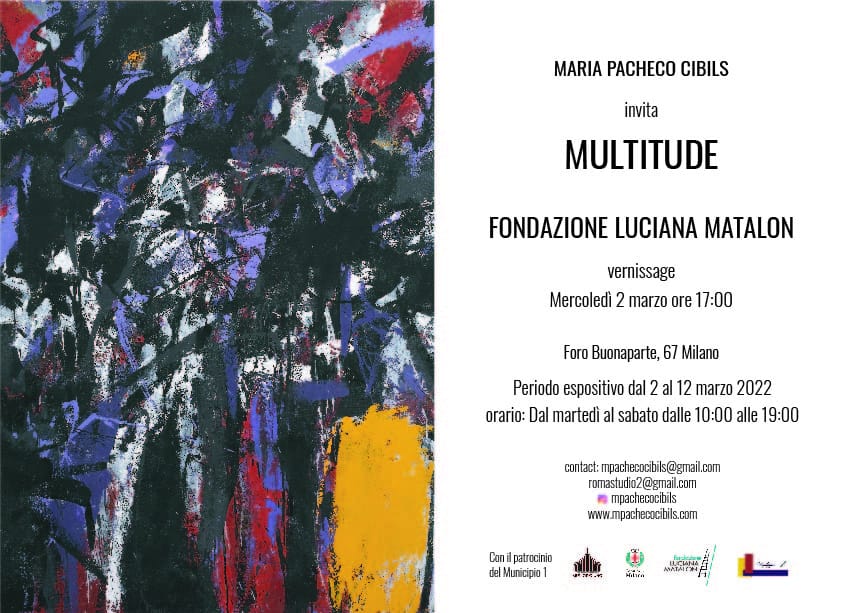
The Luciana Matalon Foundation was born in 2000 from the desire of Luciana Matalon to create a space that is an international crossroads for new ideas, an opportunity for visual, emotional and mental enrichment.
The Foundation hosts in its large headquarters, historical and contemporary exhibitions of painting and sculpture artists and photography.
In recent years it has consolidated a special relationship with the East by welcoming exhibition projects from not only Japan, but also from Korea and China and promoting Luciana Matalon’s exhibitions in Tokyo, Yokohama and Hong Kong.
The museum area behind also guarantees space-time continuity to the work of Luciana Matalon, multifaceted artist, painter, sculptor and jewelry maker; a complete archive documents more than fifty years of activity in America, Europe and Japan.
The museum space itself is a work of art: conceived and customized in every part by the artist, it is characterized by a pavement consisting of a pictorial intervention that makes use of resins and optical fibers and welcomes refusals and notes by the author herself.
Distinctive element of “Multitude” emblematic title of the new exhibition curated by Anna lsopo of Arte Borgo Gallery, is the multitude of expressive languages connected by the linear “inner identity” of the artists.
The exhibition focuses on the expressive singularity of each individual author in which painting, sculpture and photography define a complex artistic path that develops from their stories and their cultures whose differences are not in contrast but characterize the definition of art as an unconscious expression of feelings.
The multitude of works draws a multiple line, not fragmented, welded by the need for expression as an exercise of the soul and mind, an evident representation of harmony and singularity, an extension of relationship between art and life, essential content of every work.
SYNESTHESIA – Museo Francesco Gonzaga – Manova
SYNESTHESIA
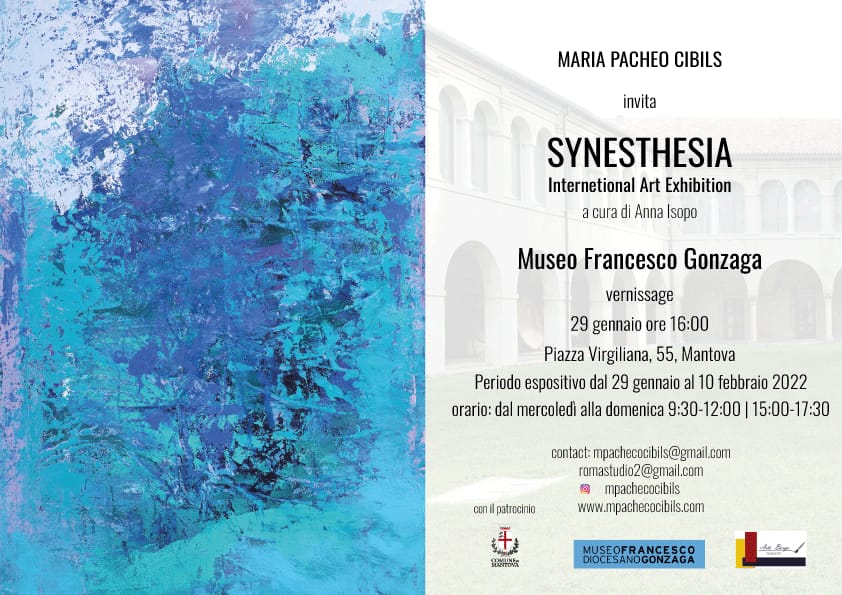 An ancient city, Mantua reached its splendor during the domination of the Gonzaga lordship.
An ancient city, Mantua reached its splendor during the domination of the Gonzaga lordship.
Rich in history and art, it shows itself as a precious container for numerous works by great artists who have left precious traces of it.
Poprio the legacy left by the Gonzagas makes Mantua one of the most important centers of the Italian and European Renaissance. it was inaugurated as a permanent museum in 1983 and set up in the ancient Augustinian monastery of Sant’Agnese.
It collects significant and precious works of art among paintings. sculptures, goldsmiths, textiles1 illuminated books, ceramics, ivories and even weapons and armor. It carries out the work of
protection, conservation and promotion of the ecclesiastical heritage. After the opening, the first nucleus of the exhibited objects went rapidly growing, also due to substantial donations from private individuals, and in parallel the space destined for them was enlarged, to the point of constituting one of the major diocesan museums in Italy in terms of value and importance. of the works kept.
SYNESTHESIA is the title of the new exhibition organized by Anna Isopo of Arte Borgo Gallery hosted at the Francesco Gonzaga Museum in Mantua from 29 January to 10 February 2022.
An international exhibition involving artists oriented in the various expressions of contemporary art from the abstract to the figurative from the surrealistic to the dreamlike, from sculpture to drawing.
The paradigmatic title “SYNESTHESIA” refers precisely to the sensorial-perceptive principle in involving multiple senses. The aim of the exhibition is to grant the observer an experience that allows them to use their senses to reconsider what appears.
The works on display outline a dialogue between shapes, lines and colors between the different expressive languages. Figurative art is represented by identifiable images of reality or made indefinite through subjective interpretations. The complex sculptures show the distinct interpretations of contemporaneity through the experimentation of innovative materials and tradition. These works dispense emotions that go beyond the aesthetic aspect, generating profound contents capable of sensitizing observers.
Rome Art Week 2021 – Luminescenza
Biblioteca Angelica – Roma
Rome Art Week 2021 - Luminescenza
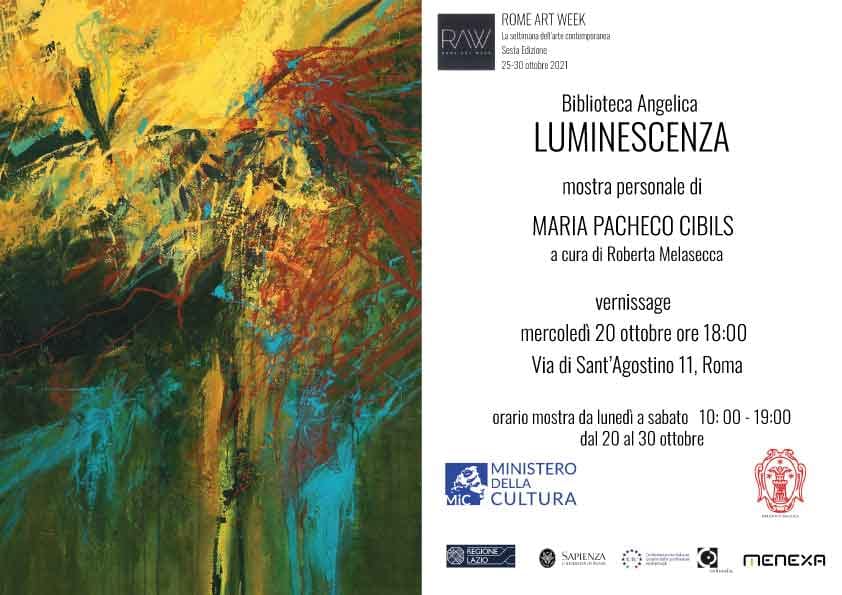
LUMINESCENCE
Brightness. Shimmering. Glare. Brightness. Splendor. Phosphorescence. Glow.
I chose the fireflies, these tiny luminescent beings, messangers of the wonder of nature, metaphors of childhood, stars that fall between us to indicate the path of life in the dark of night, support and reinforcement to overcome difficulties of modern society, extremely Fragile beings.
Its light is a call for awareness and also an invitation to transform ourselves into living symbols that survive in our threatened humanity.
Life also breathes when we sleep, fireflies are a link between sleep and dawn, like small horizons, limits and openings, they indicate our place and our possibilities of movement in the game of our existence.
Intuition and inspiration, magical messengers of the unconscious, bearers of answers to be interpreted with authenticity and a renewed consciousness. Fascination and elegance, transmission of peace is its purest soul, spontaneously intriguing, his paths of light.
Art can be the reinvention of new and better relationships between individuals and everything thapopulates the Universe in which we live.
Fragile spirits, seeking answers, limit themselves to interprete signals, to communicate and anticipate.
The fireflies thus emanate a new vision, inspiring the inner probing, unifying and verifying the being, they are precisely to indicate a new splendor to us on this long road.
Maria Pacheco Cibils
“A man can be an enemy of other men, of other moments, but not of a country: not of fireflies, of
words, of gardens, of waterways, of sunsets”.
Jorge Luis Borges
LUMINESCENCIA / ROBERTA MELASECCA
“The full moon deceived the firefly / It will be the effect of the economy, but the light you carry is weak … / – If it says that – the light is mine”.
In 1975 Pier Paolo Pasolini published an article in the Corriere della Sera with the title: “The power vacuum in Italy”, in which he made a sociological and political analysis, taking the poetic-literary image of the disappearance of the fireflies and putting in evidence the history of Italy before and after.
[….] ”. Because I am a writer and I write controversially, or at least I argue with other writers, they let me give a definition of a poetic-literary nature of that phenomenon that happened in Italy tenyears ago []. In the sixties, Due to air pollution, and especially in the countryside because of water pollution (blue rivers and transparent streams), fireflies have started to disappear. The phenomenon was sudden and sudden. After a few years, there were no more fireflies. (They are now a memory, quite heartbreaking from the past. And a great man who has such a memory, cannot recognize himself in the new young people, himself young, and therefore cannot have the good regrets of the past). That something that happened about ten years ago we will call “disappearance of the fireflies.”
Pasolini thus proposes a reading of the metamorphosis of power in Italy, identifying a substantial continuity between fascism and the republic, which was born in 1946, and a radical discontinuity after the years of the immediate “after-war” and the years of the economic boom. The disappearance of the fireflies coincides with the vacuum of power and ideals – with the passage then, from the modern era to that postmodern, cannot be filled with a simple modernization of techniques and technologies or with the advent of a new era in evolution that confuses, instead of a well-being with a purely false economic growth.
The advance of social stereotypy and globalization have put, and continue to seriously jeopardize what Geoges Didi-Huberman defines in his 2010 book Like Fireflies. A politics of survival Men – fireflies, words – fireflies, wisdom – fireflies. Recognizing Pasolini’s analysis of modernity, the French philosopher and art historian nevertheless claims that fireflies are still possible in our contemporary society, even if they are in flashes and strokes, and that the moment of mourning for a past now lost, can, on the other hand, paralyze the intelligence of the present.
The path of discovery of fireflies is therefore a journey into the void of the night, where they still survive and love each other, fleeing from the “effect of the economy”, from the liquidity of today’s society, dominated by appearances, as the only value, due to unbridled consumerism and from the exploitation and depletion of natural resources, and the search on the other hand, of a capacity to feel oneself within a unique system of nature, culture and life that illuminates that real love , rooted in one’s own way of being. (cit. Pasolini). Thus the human being – firefly is an entity capable of producing light in an autonomous mode and, like the bioluminescence of the firefly,
this is its constitutive physical characteristic, it has an interior light, it shines with its own light and does not reflect, it is a witness to a new humanism that repositiones it in a renewed symbiosis in transformation, within a structure of which an integrated and integral element is discovered.
Maria Pacheco Cibils with her latest project Luminescienza, a natural evolution of the previous ones Fuoco o della Rigenerazione, Fuoco – Eternitá – Sapere, Dimensioni Parallele “and” Il tempo sospeso continues her reflection on natural elements and on the relationship between man and the ecosystem, discovering herself a woman – firefly, discovering herself heir and actress of a
complex society in contradiction, attempting a journey of knowledge and discovery through thought, the word made into images, a fragile wisdom in composition.
With an instinctive and passionate feelings, he reveals fluid concretions of earth, water, air and fire that materialize in large-format works and in a sound video installation. The seventeen canvases that are displayed in the unique space of the Angelica Library, unravel the consequent themes of: Nature / Reflections / Light / Fireflies.
The artist outlines movements towards the interior, introverts with a predilection for colors and cold tones from green to blue, and many towards the exterior, extroverts using in the different series, colors and warm tones from red to orange. Fire, the purifying and vivifying element, the air vital energy, the water source of life, the earth, primordial matter, face and confront each other in flashes and lights, to later tighten up in an eternal loving dance of small fixed and intermittent headlights.
On the ground, with a gesture of compassion and shock, the artist scatters fragments of life and thoughts, images of things past and lost, vague and indefinite reflections of survival, evidence of death and life, manifested as indestructible desires.
Dazzled by the glare of the current Anthropocene in which there is no longer a clear separation between the natural and the cultural, we can still see fireflies appear perhaps by an extreme action of imitating their freedom of movement: while they abandon the safest path and obviously, they create other worlds, other sparks of humanity (for the moment intermittent and clandestine).
[….] In any case, as for me (if this has any interest for the reader) it is clear: even if I am a multinational, I would give all the Montedison for a firefly”.
Description
Video sound installation located in the rear part of the Gallery in a 25 square meters space. Walls and floor in black. Dank and closed, and set up like of a small cinema hall with only one entrance. The images are projected simultaneously by two different proyectos, one on the wall and the other on the floor above the platform raised from the ground floor which contains organic elements from woods.
The flashing dance of fireflies and the sound of nature in the dark of night are continuously reproduced.
Collaboration: Niccoló Di Ferdinando (ANTIFIGURE): author of the video, composing the audio and editing.
Project: Maria Pacheco Cibils
“Infinity Art”. International Exibition of Contemporary Art
INFINITY ART
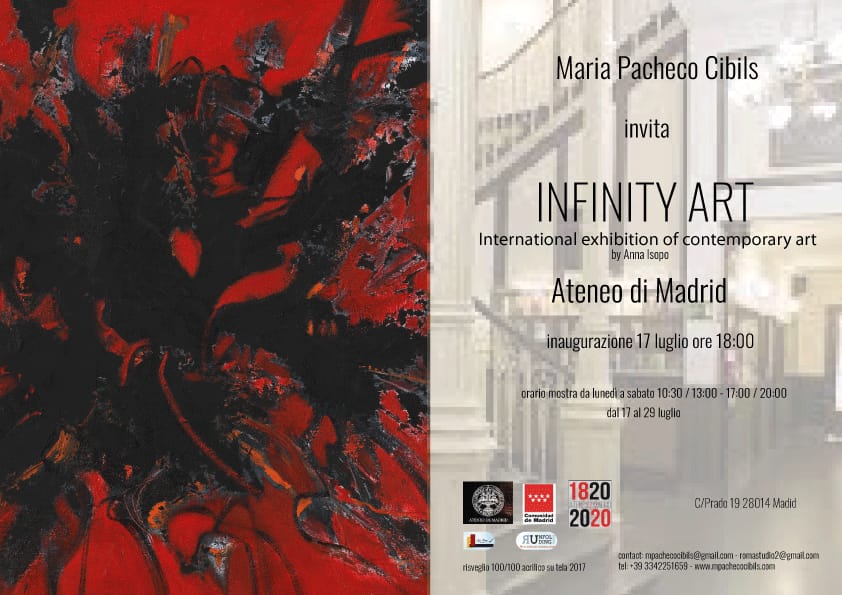 The Ateneo de Madrid is one of the largest cul- tural venues in the Spanish capital. A private cultural institution dedicated to the dissemination of arts, science and letters, founded in 1835 by some of the highest Spanish cultural personalities with the name of Scientific, Literary and Artistic University of Madrid, thanks to the romantic-liberal wind of the time brought by the then regent Maria Cristina of Naples.
The Ateneo de Madrid is one of the largest cul- tural venues in the Spanish capital. A private cultural institution dedicated to the dissemination of arts, science and letters, founded in 1835 by some of the highest Spanish cultural personalities with the name of Scientific, Literary and Artistic University of Madrid, thanks to the romantic-liberal wind of the time brought by the then regent Maria Cristina of Naples.
The
University is a long-standing institution, which had great relevance in Spanish cultural life of the nineteenth and early twentieth centuries, serving as a forum for debate and a space in i which to freely express one’s ideas. A place of great historical value, a unique institution of its kind for two centuries, a reference both in Spain and internationally.
In addition to hosting important exhibitions by contemporary artists, the University hosts portraits and works of some important personalities, including some works by Rosales and Madrazo; however, the real jewel of the building is the constantly expanding library, which today contains over 200,000 volume
Anna Isopo of Arte Borgo Gallery presents the new exhibition entitled Infinity Art at the prestigious Sala Prado of the Ateneo de Madrid. On display the works of forty international artists who propose works in which the sensitivity of the authors prevails.
Infinity Art brings together the different languages that give life to reflections and emotions that only art is able to convey, works in which the emotional state of the artist detaches himself from reality and resumes contact with spirituality. An exhibition in which infinite art unites different cultures and is considered an element of relationship and connection between artists and observers.
Infinite Art becomes a combination of past and present in which the historical soul of the bicen tennial halls of the University, which has always been a favorite place for artists, merges with the contemporaneity of the works.
“Dialogo tra le Antitesis” Protagonisti Contemporanei.
Museo Crocetti.
Dialogo tra le antitesi
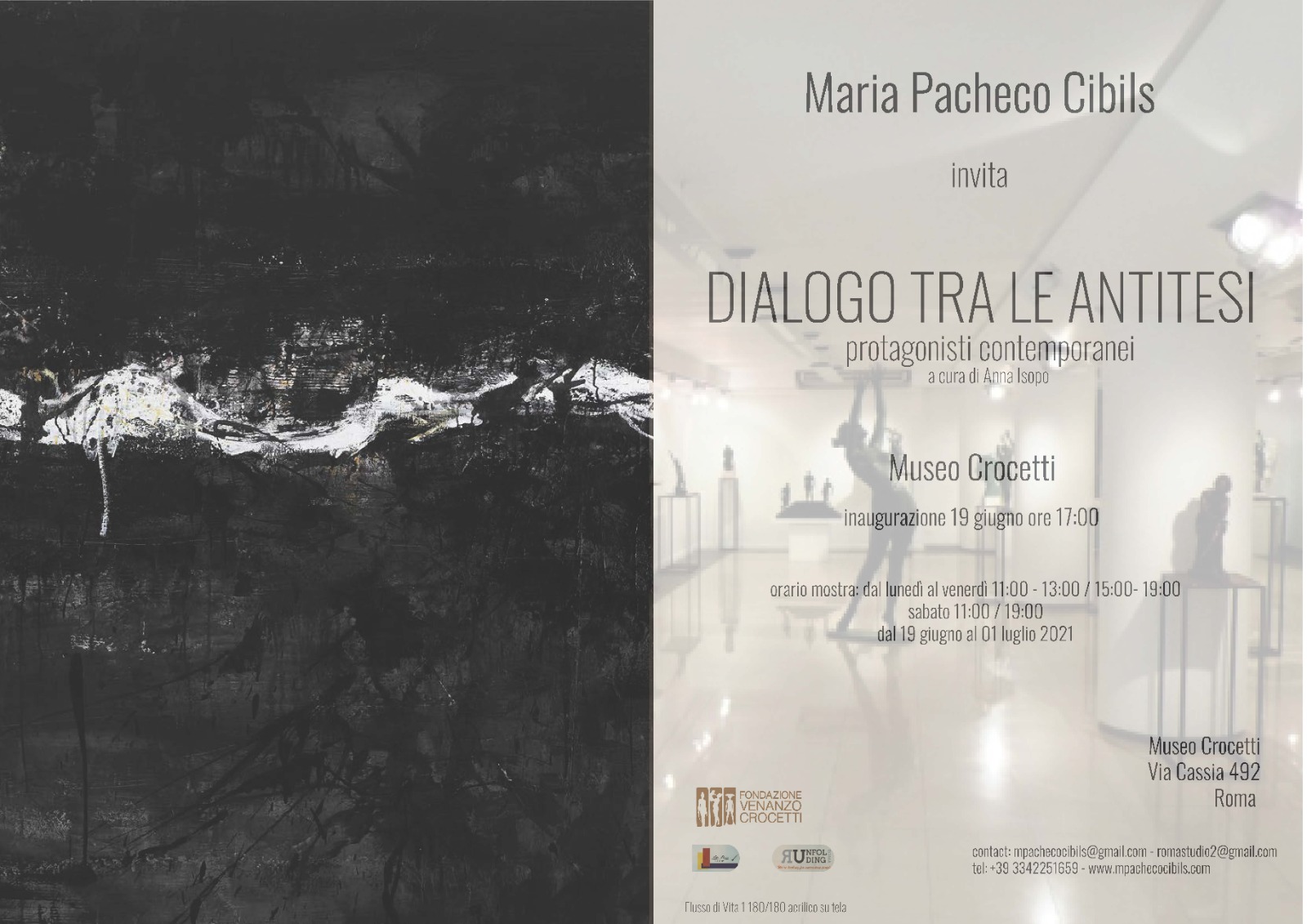
The Crocetti Museum is a museum of contemporary art dedicated to the work of the Italian sculptor Ve-nanzo Crocetti(1913-2003).
The structure was created to have a large studio that allows him to create the Porta dei Sacramenti, following the competition won in 1951, for the con-struction of the Porta di San Pietro.
Other rooms are added to the laboratory:
the house where the ma-ster lives to death and the museum, inaugurated in 2002, which houses his works.
The museum complex is managed by the
Crocetti Foundation which has as its main purpose the con-servation of the sculptor’s work and keeps his archi-ve. The museum preserves more than one hundred great works including bronze and marble sculptures, paintings, works on paper and documents by the Abruzzo sculptor, ranging from 1930 to 1998.
A comparison of opposing visual languages distinguishes the exhibition Dialogo tra le Antitesi curated by Anna Isopo. The exhibition features works placing various stylistic differences of the authors in antithesis through a dialogue emphasizing their personal experimentation and narration.
A game of opposite connections that ranges from painting to photography, from drawing to sculpture giving life to vibrant and energetic contrasts, however, establishing a harmonious dialogue open to a reflective content. A way of telling a story where each individual expression reveals a desire to tell and introduce oneself creating an exchange with the observer.
“In Contemporanea” Arte tra sperimentazione e ricerca.
Ambasciata della Repubblica Araba D’Egitto.
IN CONTEMPORANEA
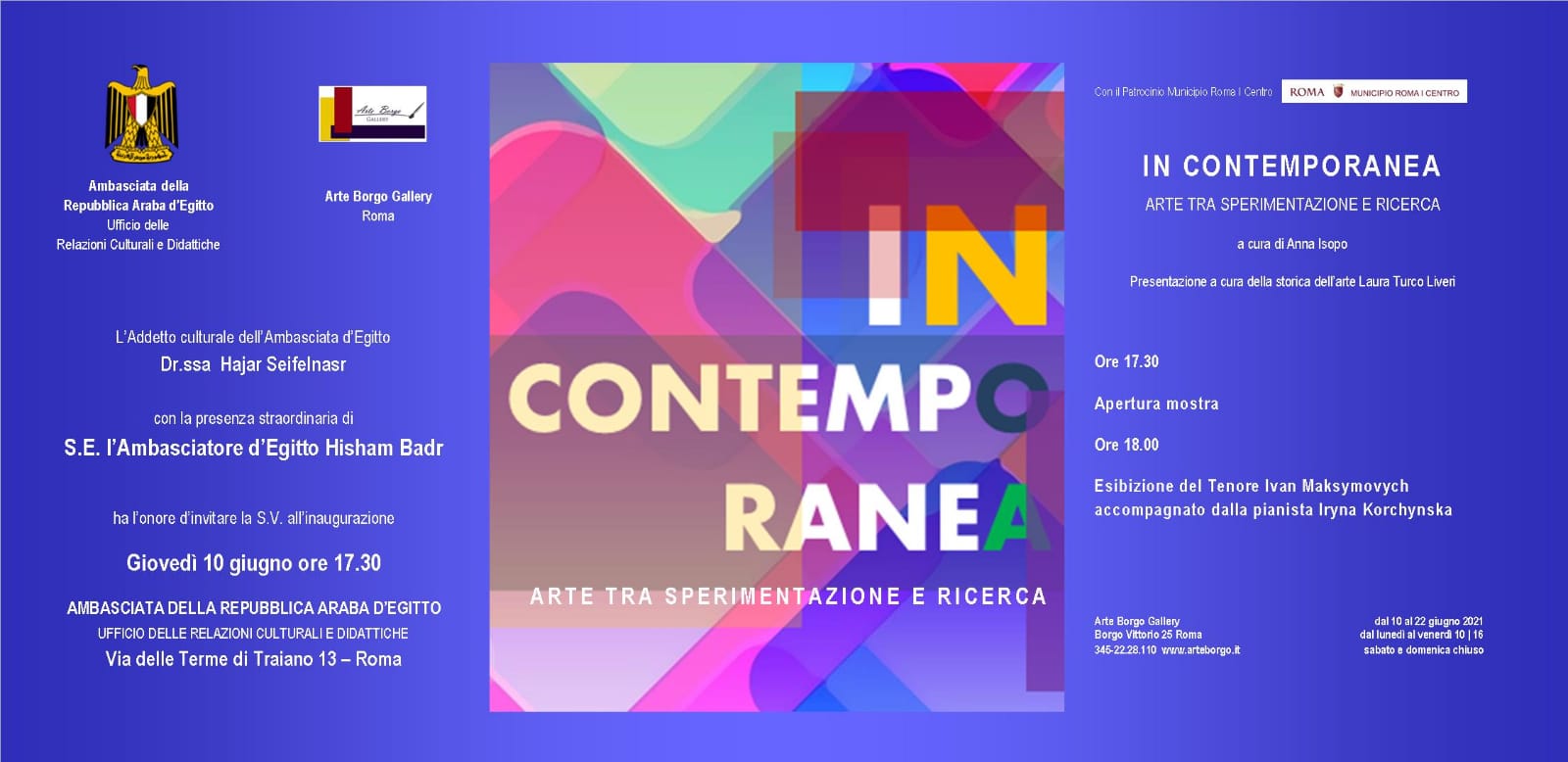 The testing of varius artistic languages alongside a research of great importance is the news exhibition promoted by Anna Isopo of Arte Borgo Gallery at the Departament of Cultural and Didactic Relations of the Embassy of the Arab Republic of Egypt whith the participation of Dr.ssa Hajar Seifehasr.
The testing of varius artistic languages alongside a research of great importance is the news exhibition promoted by Anna Isopo of Arte Borgo Gallery at the Departament of Cultural and Didactic Relations of the Embassy of the Arab Republic of Egypt whith the participation of Dr.ssa Hajar Seifehasr.
“IN CONTEMPORANEA”arte tra sperimentazione e ricerca ,is the title of the collective exibition that though painting,sculpture,graphics and photography works doesn’t purposely reveal its common thread but intends to be an encounter between artist who though their different stylistic ,linguistic, and symbolic modalities offer us the opportunity to reflect on the meaning of art by giving us the opportunity to reflect on the meaning of art by giving us the opportunity to continue to enjoy it and giving the observer emotions that are forcibly subsided by the events.
An exhibition in which multiculturalism and passion are an opportunity to reflect on the relationship between man and nature ,between form and matter, between figuration and abstraction fueling a sense of collective participation.
“Trame Contemporanee” Mostra Internazionale d’Arte Contemporanea.
Palazzo della Cancelleria Vaticana
TRAME CONTEMPORANEE
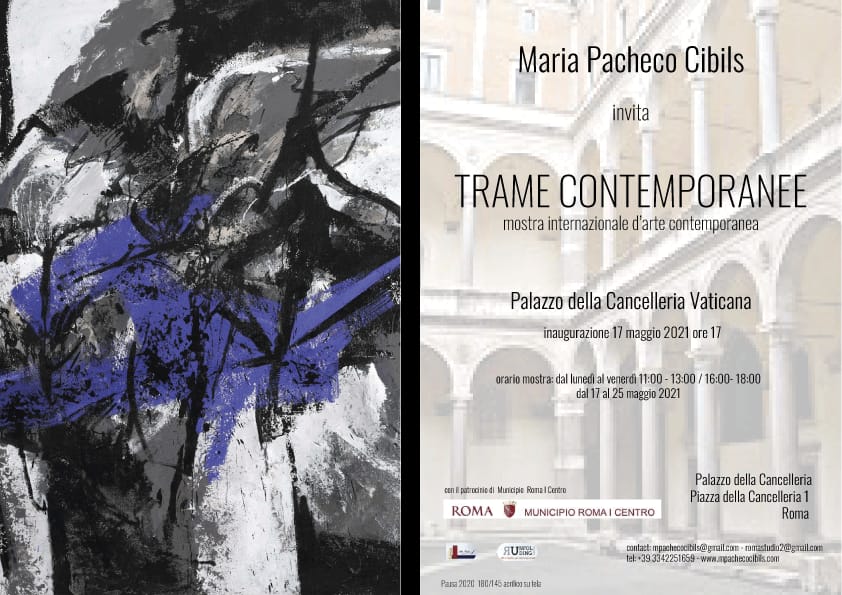 is the new exhibition curated by Anna Isopo. It is hosted in the splendid rooms of the Palazzo della Can- celleria Vaticana, one of the most prestigious sites in the heart of the Eternal City.
is the new exhibition curated by Anna Isopo. It is hosted in the splendid rooms of the Palazzo della Can- celleria Vaticana, one of the most prestigious sites in the heart of the Eternal City.
Forty artists of the international contemporary art scene present their works focusing attention and reflection on the importance of contemporary art as a dialogue full of sto ries, feelings and emotions. Plots are interpreted and told through various forms of art with the versatility and universality that distinguishes each artist.
Painting, sculture and photography are the fascinating and kaleidoscopic textures with different expressive languages connected by emotional affinities. It is a moment of sharing in which beauty, taste and form interact with the environments of the Palazzo dellaCancelleria Vaticana.
Located in the heart of the Eternal City, the Palace of the Vatican Chancellery, built in late 1500s by Cardinal Raffaele Riario, is a beautiful building in the new Renaissance style. Throughout its ex-istence, it has served the role of the historic headquarters of the Apostolic Chancellery, where today the main courts of the Holy See reside.
The Palace enjoys a reputation of being one of the most fascinating palaces in Rome, thanks to the beauty of the bone-colored travertine, obtained directly from the ruins of the Theatre of Pompey, and its internal courtyard, the result of a splendid project by Bramante.
The noble floor of the Palace houses countless works by great artists: from the vault of the Salone di Studio frescoed by Perin del Vaga to the famous Salone dei Cento Giorni (The Hall of One Hundred Days). There is a vast mural that honors the pontificate of Paul III Farnese. It was frescoed by Giorgio Vasari and tells one of the most interesting anecdotes about this extraordinary
place: it is said that it took Vasari exactly 100 days to complete the work, as requested by the client.
Rome Art Week 2020 – Il tempo sospeso
Biblioteca Angelica – Roma
Rome Art Week 2020 - Il tempo sospeso
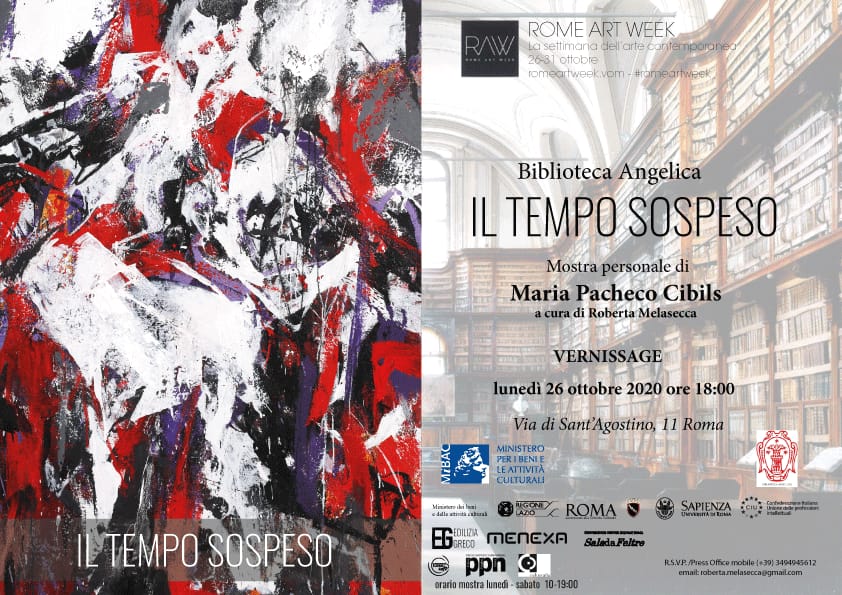
Il Messaggero “di Roma
“IL TEMPO SOSPESO “di Maria Pacheco Cibils
Time stops being succession and returns to being what it was and is originally, a present, where past and future are finally reconciled “
Octavio Paz
Still time,
but also to establish itself.
Moment of respite, of order,
waiting.
Empty and full.
Light and shadows.
Mutant, controversial energy …
Full of stories, memories, silences
of restlessness.
Music, reflections, isolation.
Ups and downs.
Meditation.
Lacks, uncertainties.
Time to get inside
to dig, investigate, discover …
Who we really are
and where we want to go.
Time to create our Universe.
Maria Pacheco Cibils
Il tempo del silenzio
di Roberta Melasecca
BIBLIOTECA ANGELICA – 26-31 OTTOBRE 2020 – MINISTERO PER I BENI E LE ATTIVITÀ CULTURALI
“My book opens and closes on images of happy cities that continually take shape and vanish, hidden in unhappy cities.” (Italo Calvino, The invisible cities)
In the spaces of the Angelica Gallery, Maria Pacheco Cibils presents her reflections during this complex period that for eight months has changed the individual and collective lives of every country in the world. Using the instrument of art, he tells of a still, fragmented time, inhabited by moments of isolation, of meditation, of real and mental order and disorder, of truce and restlessness, of discovery of inner possibilities and the capacity for resilience, as it has been since some defined. A suspended time, for her and perhaps for many of us, materialized in 33 works of various formats, from paintings 50 × 50 cm to those 180 × 180 cm to some larger ones.
Maria tells of an absolutely real time, so real that it may seem either perfectly banal or excessively impossible to transform it into words, in other words that attempt to explain, justify, express, console, object, discuss, analyze, counter, plan, expose. Each of us has been writing and speaking words every day for eight months trying to find the happy cities hidden in the unhappy cities, in the extreme and necessary attempt to give them shape and not make them disappear.
Therefore I have done a lot of research on pandemics over the centuries, on the probable causes and related consequences to try an analytical approach and with my words give a vision or a thought. But the result seems to me perfectly banal and extremely reductive.
I crossed out the words. I then attempted a philosophical and psychological reading on the concept of happiness on which literature, from the time of Epicurus to the present day, has been widely debated. An undertaking that is excessively impossible to contain in a text to be read in a few minutes, while in front of me the book by Mare Augé presents 114 non-exhaustive pages of the problem. But perhaps even a more extensive discussion could lead to the same conclusion: we have renounced defining happiness, assuming that it is a lasting condition to which it is normal to aspire (cit. Mare Augé) and to which every citizen is entitled . After all, the UN established World Happiness Day in 2013, then publishing the World Happiness Report each year, a report on world happiness that examines the quality of life in more than 150 countries and is based on several parameters: GDP pro understand, social support, healthy life expectancy, freedom to act life choices, generosity and freedom from corruption.
The UN has decreed dissertations on happiness closed, reducing them to the application of simple criteria that depend on us individually and on the structure of societies and communities. Italo Calvino would turn in the tomb (but also all thinkers from antiquity onwards). For Umberto Eco every proposal from our contemporary appears as an appeal to a happy life: the cream to firm the face, the detergent that finally removes all stains, the sofa at half price, the bitter drink after the storm, the in a box around which the happy family gathers, the beautiful and cheap car and a sanitary napkin that will allow you to get into the lift without worrying about the nose of others; and our right to the pursuit of happiness is realized in the satisfaction of the acquisition of goods but certainly not when we vote or when we send our children to school. And from the etymological and sensorial side, the concept of happiness would not exist if that of unhappiness did not appear, real and palpable: even our childhood memories, the most vivid and intense ones, are the episodes of pain, especially physical.
I remember perfectly well when I fell into a garage ramp, my right arm flayed, the tears locked in my throat and the smile printed to be strong. While I vaguely remember all the minutes of a happy child, and according to my parents there were many. Faced with the time of our distant or recent memories and the living present time, the condition of happiness should appear to be a situation in motion and instead persists in our awareness as immobile and permanent. The unhappiness caused by the rejection of the loved one exists in us as an ineluctable and not transitory condition, as an actuality that defines our life and does not give way to a future reality. Happiness for life, without doubts, pains, crises. Remaining and remaining in view of a single present allows us to avoid any definition of happiness, transforming the desire into an absolute right and into the denial and devaluation of what prevents its achievement. By measuring happiness through diagrams and graphs, working, rightly, for the parameters that define personal and social happiness, we contemporaries have become unable to come to terms with death (cit. Umberto Eco).
The disappearance of death (and unhappiness) from our continuous experience, as an event that belongs to life itself, feeds and intensifies the proliferation of words spoken and written to describe and represent my inner and outer conditions, which are confused and blend with the myriad of words spoken and written to describe and represent the inner and outer conditions of each of us 60.36 million Italians, 741.4 million Europeans, 7.594 billion inhabitants of the world.
At this point, art comes to my aid and allows me what I cannot express and define without the risk of generating an infodemic of information. Mary’s words, then, take shape and come alive in flashes of color that arise from an intimate and personal interior movement and spread collectively. They are spaces on which I can remain only for limited and unstable times; certainly they are not the answer to my and our questions and they do not calm my and our feelings. But for a single moment, for an immediate instant I can not say letters next to each other.
I can be silent.
“Writing too much is dangerous: thus, always before our eyes, engraved in indelible words, the image of what we are worth, the sincere mirror that reflects our authentic appearance.” (Andrea Erno, The incomparable voice of silence)
“Human Perceptions” Group Exibitions Contemporary Art Mostra Internazionale di Arte Contemporanea.
Co Galleries – Germany – Berlin
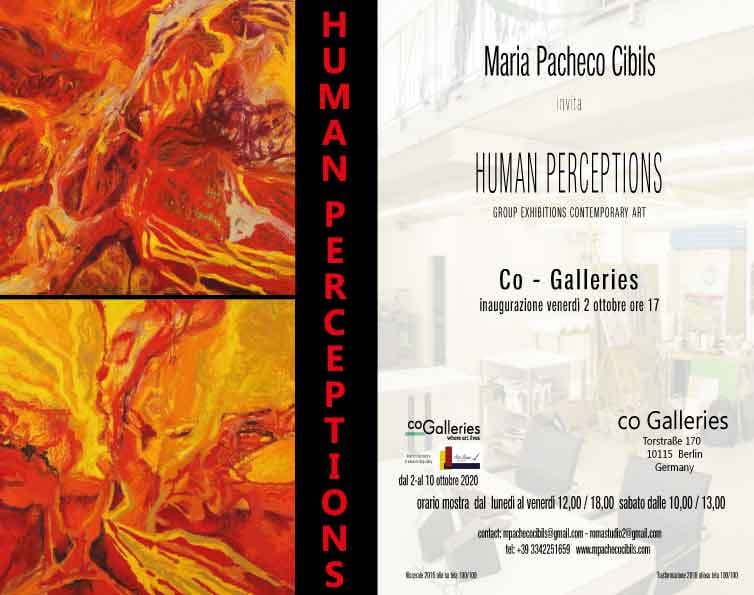
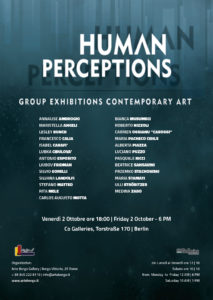
With the Human Perceptions exhibition, each artist confronts himself through the creation of a work of art on the daily issues of a human being that from ordinary turn out to be extraordinary. A perception that turns out to be extraordinary when satisfied with one’s own material needs, one examines the relationship with others, identifying something that goes beyond ourselves. Art expressed in all forms is a tool for reflection and demonstration of unusual, extraordinary … human perceptions, which manages to shape the way we relate to the world … between human beings, the environment and nature.
It will be realized with the participation of CO.GALLERIES (Berlin) located in the Mitte district in the center of this city famous for the quantity of museums and galleries of Contemporary Art.
“GENESIS” Mostra Internazionale di Arte Contemporanea.
Museo Bellini – Firenze
“GENESIS”
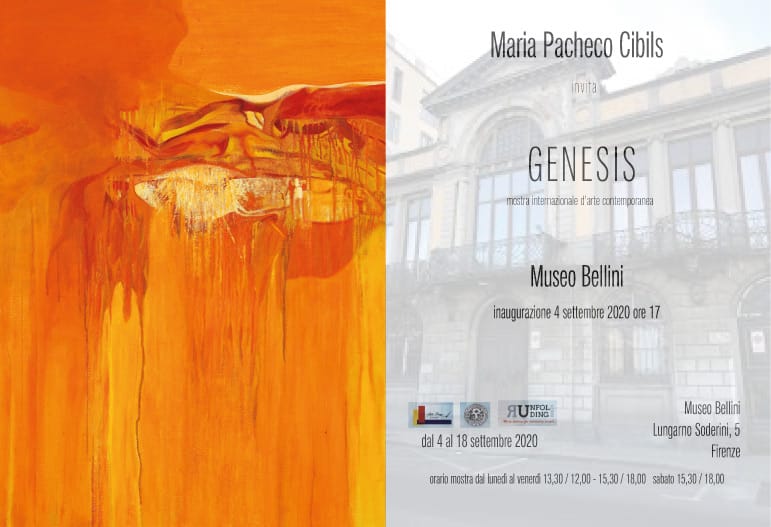
The Greek-derived term ‘GENESIS’ encomposses our concept of birth. The centrai node of on exhibition that leads artists to reflect on themes that range from the biblical creation of the world to the physical and spiritual rebirth of each of us.
Sculpture, palntlng, photogrophy, each art form portecipates in the dialogue of artists in a time, our contemporary, in which speed and immediacy have taken the piace of reflection on our daily lives, on our origins, while a new whole of values and ideas is necessary to regain possession
of the present.
Through the works on display, eoch ortist brings his personal piece within a unique path, centered on the need far human and artlstic intervention, transcending his owns
The BELLINI MUSEUM is a private museum in Florence located on Lungarno Soderini, in Oltrarno. lt houses the collection of a family that has been a protagonist of the art market since 1756.
Warehouse N. 5 is considered the new refined and evocative location obtained, in fact, from the ancient warehouses of the Galleria Bellini, set in the fifteenth-century structure of Palazzo Soderinl whose facade was redesigned by the famous architect Coppedé, in a sìngular and fascinatìng piace located at ground floor of the Palazzo Bellini, overlooking the banks of the Arno, where you can breothe a unique atmosphere of lts kind and closely llnked to the ancient.
Arte a Venezia “Sguardi Contemporanei”
Mostra Internazionale di Arte Contemporanea.
Centro d’Arte San Vidal – Venezia
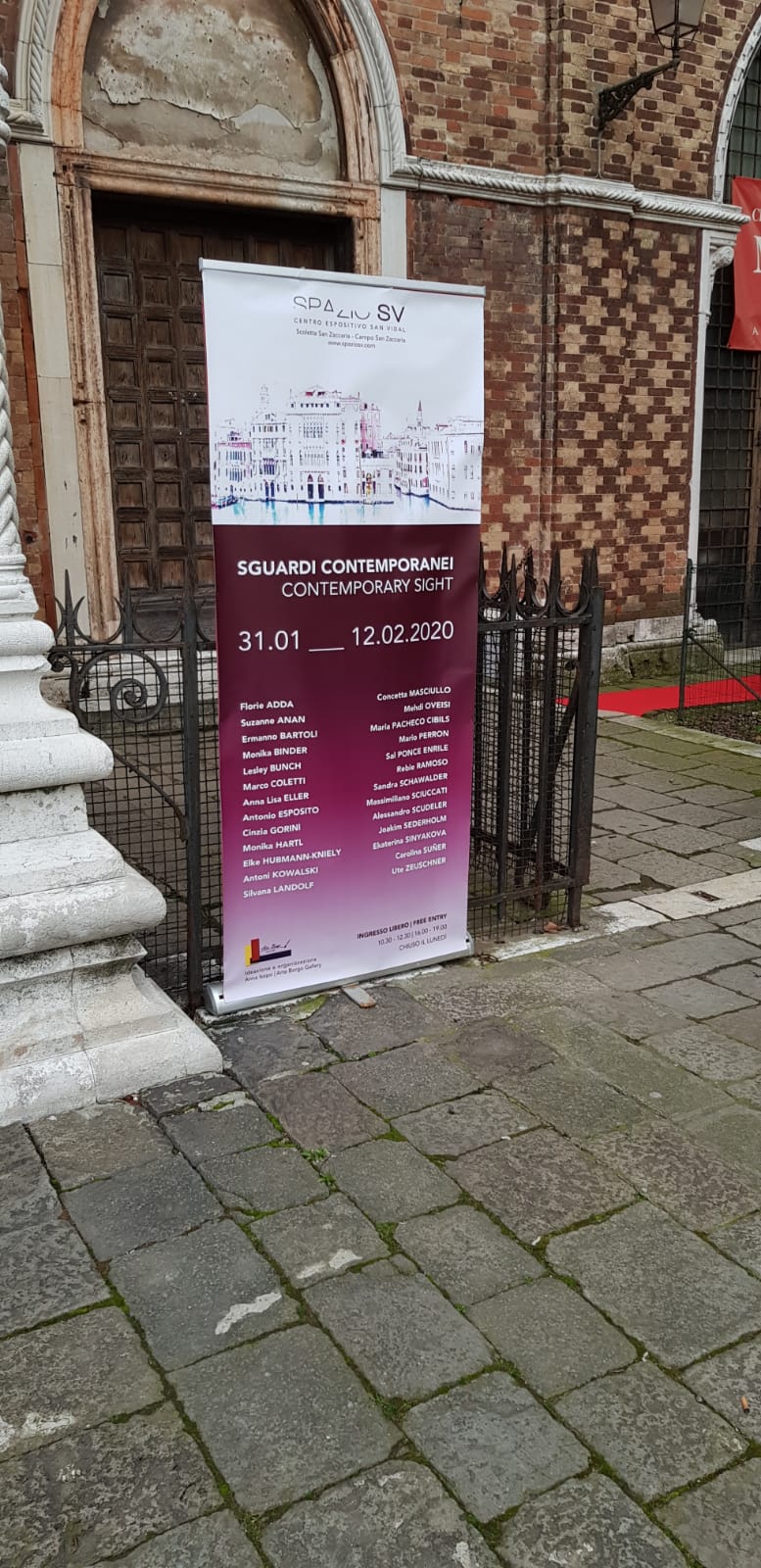 In the suggestive San Vidal Exhibition Centre the exhibition Contemporary Sight displays works by artists who tell us their feelings and
In the suggestive San Vidal Exhibition Centre the exhibition Contemporary Sight displays works by artists who tell us their feelings and
emotions in a harmonious dialogue through a variety of creative languages and styles.
With the selection of works on display, the exhibition aims at exploring the relationship between the contemporary artist and the city of Venice, a relationship that necessarily moves and reunites with the history and millenary artistic tradition of the city, its unique architecture, historical and geographical location, its role as a cultural icon and its continuous innovation in our present.
The research and sensitivity are represented with varied forms of expression in which each artist elaborates his or her vision of “Sights”,
investigating and evoking the complexity of the contemporary world, while giving the observer a new “Look”.
Contemporary Sight as a testimony of emotions and sensations that dialogue and give the observer imperceptible messages through colours and images.
Rome Art Week 2019 – DIMENSIONI PARALLELE
Salone monumentale Biblioteca Angelica – Roma
Rome Art Week 2019 - DIMENSIONI PARALLELE
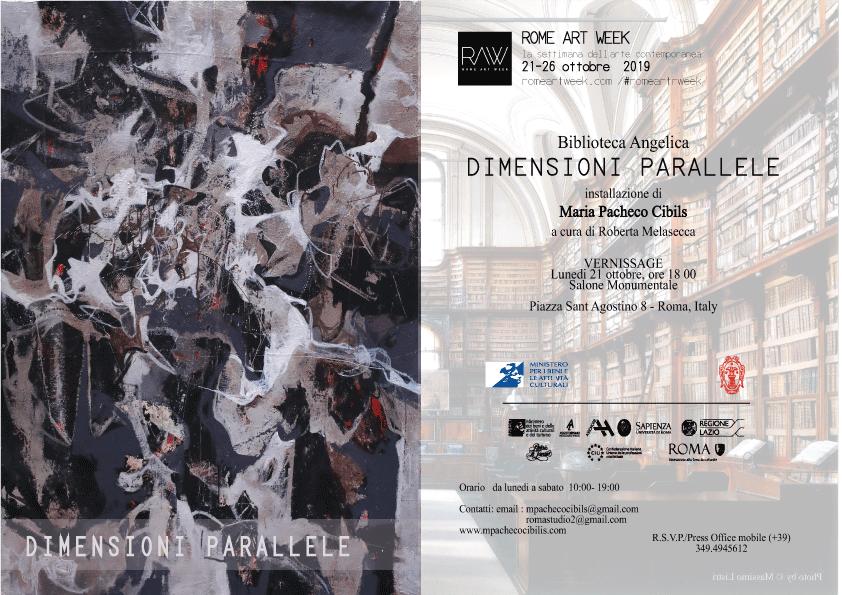 The general idea of the project wants to represent human beings, nomads, passengers of a world continuously and constantly. They support the eradication, the precariousness, the dierence of behaviors, the idioms, living two parallel worlds one known and the other imaginary bringing honor to change.
The general idea of the project wants to represent human beings, nomads, passengers of a world continuously and constantly. They support the eradication, the precariousness, the dierence of behaviors, the idioms, living two parallel worlds one known and the other imaginary bringing honor to change.
Description of the work installation composed of structures, sculptures, paintings and platform of natural elements.
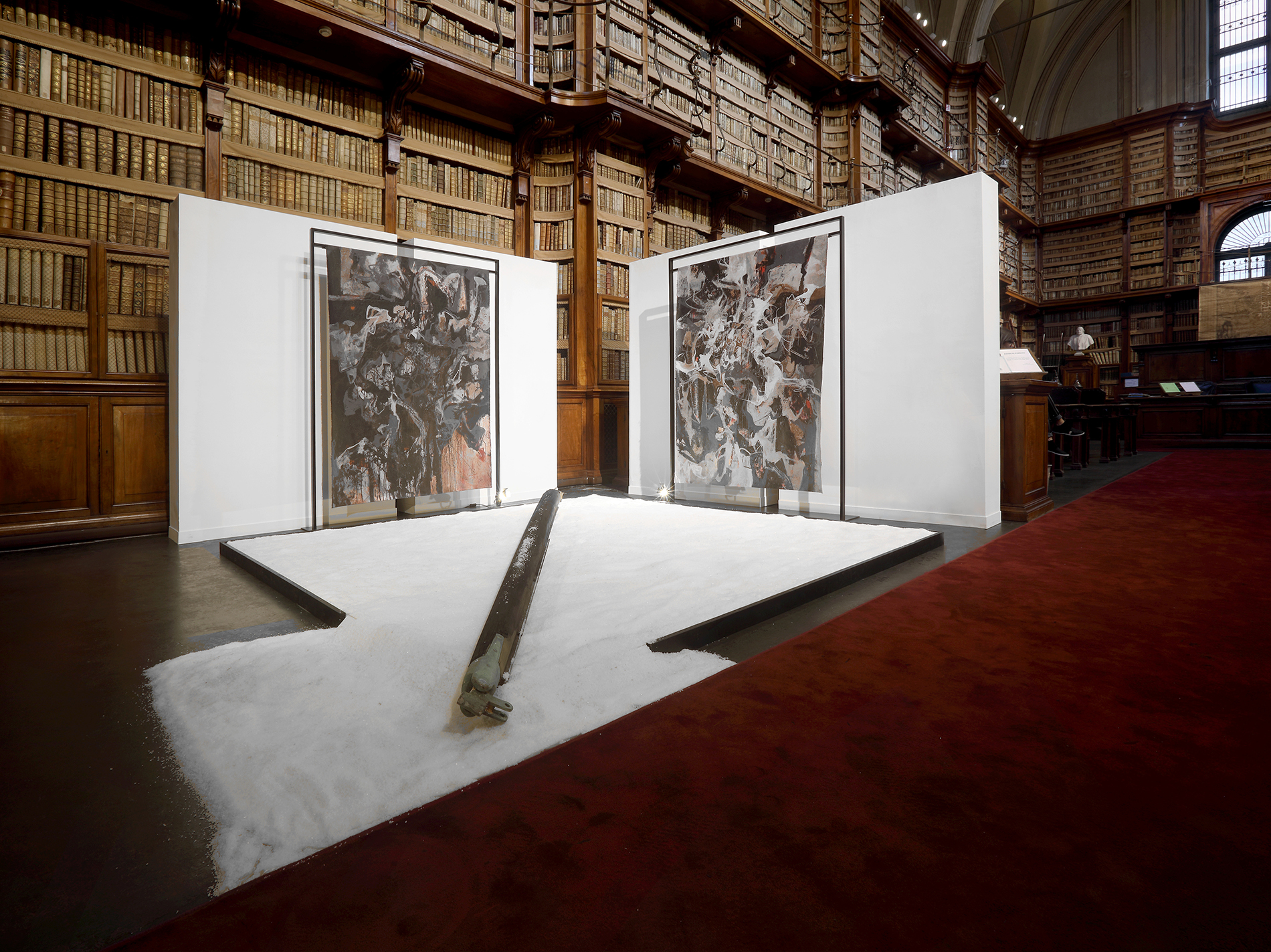
Installation of Biblioteca Angelica Salone Monumental cura of Roberta Melasecca
Maria Pacheco Cibils
Parallel dimensions
by Roberta Melasecca
“Who, even if only to a certain extent has reached the freedom of reason, cannot but feel on earth nothing but a traveler but a traveler bound for a final destination: because this does not exist. Instead, he will want to look and keep his eyes. well open, to realize how things really proceed in the world; therefore he will not be able to bind his heart too firmly to any particular thing: there must be something wandering in him that finds his joy in change and transience “
( Friedrich Nietzche, The Viadante, Aphorism 638, Human too human)
The scientific discoveries of Luigi Luca Cavalli Sforza on chromosomes and his studies on the genetics of populations, on human migration and on the interactions between genes and culture have highlighted how the human community, since the time of the first hominids that left the African continent, around 100 thousand years ago to colonize the rest of the planet, it was a continuum in perennial migration.
there is the essence of something wandering in us, we are viadants directed towards a perhaps nonexistent destination, because it is rooted in an intimate “sacred” itinerary where the past weighs on the present and contains all the probable events of the future. , has always characterized the human condition, is a fundamental part of the nature of man so much to spesify its identity, it is a category of the spirit and ethical imperative, it is tension towards the unknown, discovery of external and internal worlds. birth and rebirth, and at the same time abandonment and separation. Already in its etymology the verb to leave has analogies with the verb to give birth: both contain the concept of new being. To give birth derives from pario to which it is connected parare (buy, prepare) and separate (remove ); starting derives from the side and its meaning is to start again, to distribute the parts and therefore to separate.
The departure and more generally the journey, the physical and spiritual movement, identifies two dimensions, not always consequential, but often coexisting – beginning and end, birth and death, abandonment and acquisition – which represent visions and realities of the individuation process. inside and moving: those who migrate challenge the fear of abandoning certainties and their habitat, overcome and redefine boundaries, bring with them stories related to the primeval place and cross them in a path of continuous movement, imagine an evolution that shapes the world circonstante.
Maria Pacheco Cibils gets to know the peregrinations of the soul and body: moving between Italy, Argentina and Portugal she experiences known and unprecedented dimensions every day and her artistic research is imbued with faces, spaces and imaginaries. Each of his works is the result of a decisive choice, the conquest of autonomy, a renewed awareness of himself, an experience of permanent conversion. in the spaces of the Angelica Library, where the moment is suspended in invisible thresholds, the artist insinuates himself generating a synchrony of times and a stratification of places.
The parallel dimensions installation defines a path of patience and constancy, of poignant detachments and raw abandonments, of slow and inevitable changes; tells of stories that require forms of ductility and that testify changing passages. The artist, migrating by himself, stages and builds an open life project: he crosses a sea of different events and, settling in a condition of permanent wandering, arrives in still floating sands. The diptych, which fluidly stands out within a specific structure, is the cathartic journey of one’s consciousness which proceeds in a cyclical round trip system, founding the roots in the play of opposites and contrasts; while from the shadow of memories and memories the artist pierces the spatial plane through a linear material axis from which distant voices of despair and hope are heard. The use of only two colors, black and white, affirms the evidence of a duality that does not necessarily resolve itself in a seraphic attestation of reality, but accentuates the going and the going towards the shores of the soul.
Parallel dimensions is therefore not the reflection of the artist’s personal and private experience but a collective existential state, where we all recognize ourselves as migrants, by necessity or by the need for research, different horizons and different points of view, to survive sometimes and not abandon expectations.
“And immediately the journey resumes / as / after the shipwreck / a sueprstile / catfish”
(Giuseppe Ungaretti, Allegria di naufragi, 1917)
DIMENSIONI PARALLELE – installazione composta da strutture varie, sculture, dipinti su piattaforma di Maria Pacheco Cibils a cura di Roberta Melasecca.La Biblioteca Angelica MiBACT ha presentato oggi lunedì 21 ottobre presso il Salone Monumentale della Biblioteca, l’installazione Dimensioni parallele dell’artista argentino-portoghese Maria Pacheco Cibils, a cura di Roberta Melasecca.#mariapachecocibils #arte #mostra #bibliotecaangelica #roma #robertamelasecca #artegoit #art #artist #artwork #artgallery #artshow#romeartweek2019
Publiée par UnfoldingRoma magazine sur Lundi 21 octobre 2019
Piazza Sant'Agostino
Publiée par Bellezze di Roma sur Samedi 19 octobre 2019
Rome Art Week 2017 – FUOCO – ETERNITA’- SAPERE
Angelica Library – Gallery | Rome
Rome Art Week 2017 - FUOCO - ETERNITA'- SAPERE
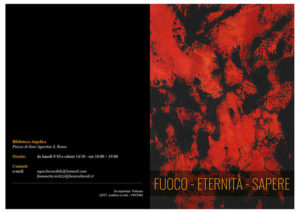 On the occasion of Rome Art Week 2017, the Angelica Library (MiBACT) presents the installation by the Argentine Portuguese artist Maria Pacheco Cibils, “Fuoco – Eternità – Sapere”, on Monday 9 October 2017 at 6pm, at the Monumental Library Hall.
On the occasion of Rome Art Week 2017, the Angelica Library (MiBACT) presents the installation by the Argentine Portuguese artist Maria Pacheco Cibils, “Fuoco – Eternità – Sapere”, on Monday 9 October 2017 at 6pm, at the Monumental Library Hall.
Maria Pacheco Cibils wants, with her installation, to pay homage to an institution that in its four centuries of history has always represented a magical place, a silent theater of ancestral perfumes and golden reflections, synthesis of secular culture.
Through fire, primary, suggestive and fundamental element of nature and life, which with its duality totally burns the superfluous leaving only the essence, the truth emerges pure and intact, immortal and eternal, as an indestructible flame, regenerating and purifying everything in its passage.

Fire is a transforming agent, because all things are born in it, and return to it
(Eraclito)
Maria Pacheco Cibils is an Argentine-Portuguese designer and artist. His work ranges from interior architecture, renovations, settings, scenography, creation of clothes, stage costumes, objects of art and jewelry, paintings and installations. He has made numerous presentations and performances for painters and photographers; he has collaborated with prestigious magazines, newspapers and television channels for theatrical and classical and contemporary dance performances. Creator of various brands, she has developed products and graphics for them in Argentina, Paraguay and Italy. He currently works between Italy and Argentina.
Scarica la rassegna stampa | Entra nella Galleria Fotografica
THE HISTORICAL REVIEW OF THE GIRANDOLA IN MUSICAL SYNCHRONY IN PINCIO – 29 JUNE 2017
La Girandola: In mostra : Fiamma Vitale a cura di Francesca Barbi Marinetti.
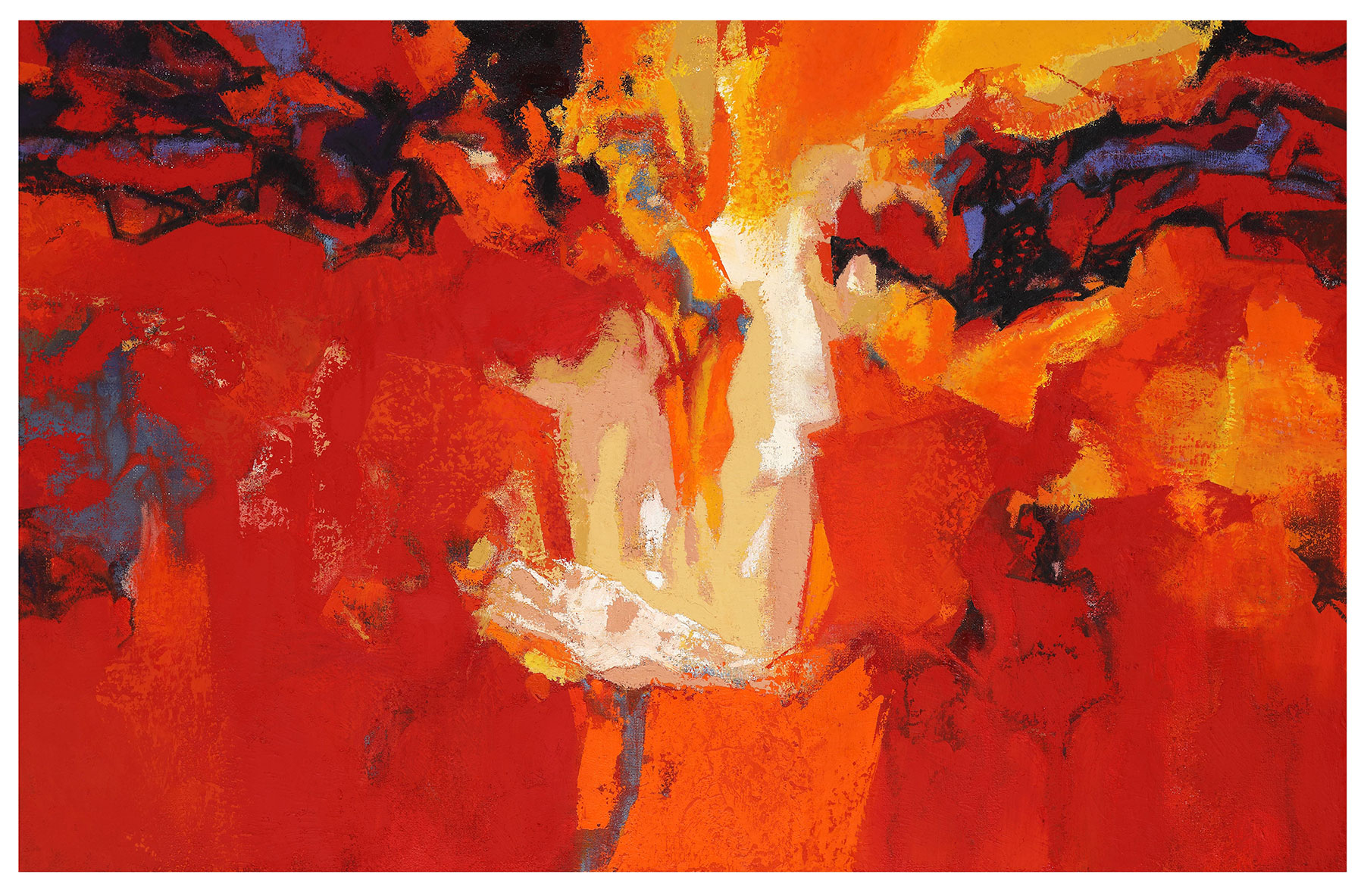 This year La Girandola, the most explosive show in Rome, hosts a work of art dedicated to the Fire of the Argentine-Portuguese artist Maria Pacheco Cibils.
This year La Girandola, the most explosive show in Rome, hosts a work of art dedicated to the Fire of the Argentine-Portuguese artist Maria Pacheco Cibils.
The occasion was offered by the Angelica Library and in particular by the will of its director Fiammetta Terlizzi.
In these prestigious rooms between May and June of this year, the artist Pacheco Cibils was present with his first solo show in Italy entitled “Fire or Regeneration”. Presentation by Barbara Martusciello. Among twenty-eight large format paintings belonging to a series dedicated to one of the four natural elements, the Fire, the great work “Fiamma Vitale” has been selected for the dynamic and vibrating energy mobility of the pictorial gesture. They are paintings of the material strokes and decided where the colors of the fire predominate. bright red, referring to the primordial regenerating power. Fire, citing the words of the artist Maria Pacheco Cibils, is the symbol of light and sun, of passion and purification, it is like Araba Fenice that brusquely recreates and evolves, it is what unites and separates matter from spirit.
An image that accompanies the now appointment with the baroque fires of the Pinwheel, so full of history but in step with new technologies so as to offer today’s spectators a renewed magnificence.
STORIA DELLA GIRANDOLA
Si quid de arce S. Angeli dicam quae ex ignibus undequaque tam vivacibus tacque multis, ut ardens fornai unus putaretur, tum radiis in coelum usque porrectis, et sclopis pene non credendis, et girandulis tam mire fabricatis, coruscabat, rutillabat, tonabat, ut omnes non minus ab aspectu quasi attoniti admirarentur, …………… ne coelum ipsum quid rueret.
PARIDE DE GRASSIS (1470-1528) ediz. Frati pg. 327
Se dovessi dir qualcosa su Castel S. Angelo, il quale a causa di fuochi da ogni parte così vivaci e così numerosi sembrava un’ardente fornace, quando per bagliori sino al cielo e per granate quasi incredibili e girandole cosi mirabilmente fabbricate, brillava, rosseggiava, rimbombava in modo che tutti si meravigliavano quasi attoniti ……………………..come che qualcosa facesse venir giù lo stesso cielo.
(Traduzione mons. Antonio Pelosi, sez. Latinisti Città del Vaticano)
Con queste parole Paride De Grassis, maestro delle Cerimonie Liturgiche di Papa Giulio II, descrive la Girandola intorno al ‘500. Successivamente altri maestri cerimonieri, tra cui Fulvio Servanzio e Paolo Mucanzio ci forniscono testimonianze preziose sulla complessa architettura della Girandola, descrivendone la sua straordinaria bellezza.
Nel suo trattato “De la Pirotechnia” pubblicato nel 1540, l’artigliere di Papa Paolo III, Vanoccio Biringuccio, descrive così “La Maraviglia del Tempo” : «Al terzo giro tirano molti razzi, i quali sono longhi un palmo che di poi sono andati in alto con una longha coda e che par gli habbino finito, schioppano, e mandan fuori sei o otto razzetti per uno, nella maggiore sommità del castello, dove è l’Angelo attaccato à l’arboro del stendardo, adattato una forma d’una grande stella, che contiene molti razzi».
Per capire perché uno spettacolo di questo tipo fosse tale da funzionare durevolmente e penetrare la storia di Roma, bisogna fare un salto indietro nel tempo passando in rassegna alcuni celebri personaggi che vi gravitarono attorno.
Pochi sanno che l’artista Bernardo Buontalenti (1531-1608), fortemente legato alla personalità di Michelangelo Buonarroti e al Rinascimento toscano, era soprannominato Bernardo delle girandole e Benedetto Buonmattei (1581-1648) membro dell’accademia della Crusca, l’Affumicato, proprio per la loro dedizione all’arte della pirotecnia.
Anche l’architetto Niccolò dei Pericoli detto il Tribolo (1500-1550) divenne famoso per le sue coreografie dei fuochi. La sua bottega era conosciuta in città per la fabbricazione di ordigni bellici dotati di punte metalliche: probabilmente è da questa sorta di ‘botti esplosive’ che derivò il soprannome ‘Pericoli’.
Questi personaggi, attraverso l’ideazione e la realizzazione di progetti pirotecnici, si adoperavano per celebrare la committenza dei nobili, poiché l’esecuzione dei fuochi d‟artificio a quel tempo era indice di forza e di potere.
E ancora M.A. Valena nel 1618 parla della Girandola concepita “a imitazione del vulcano Stromboli che vomita fiamme e foco”.
Fu nel 1481 per l’esaltazione al Pontificato di Sisto IV, che s’introdusse per la prima volta la Girandola, riproposta ogni anno per festeggiare eventi solenni, come la Santa Pasqua, la ricorrenza dei Santi Pietro e Paolo e l’incoronazione del nuovo Papa. La Girandola non è un soltanto uno spettacolo pirotecnico, ma un evento ideato per esaltare la bellezza della fede e la vittoria gloriosa del bene sul male.
I più grandi artisti di tutti i tempi sono stati chiamati dai Pontefici per fare della Girandola un evento in cui luce e fuoco fossero i parametri simbolici che rimandassero alla purezza e alla bellezza della fede cristiana.
Molti celebri artisti e scrittori hanno esaltato la girandola: Charles Dickens, ad esempio, scrisse della bellezza e magnificenza dei colori, che rapivano gli spettatori; il poeta romano Belli le dedicò alcuni sonetti, tra cui “Er passetto de Castel Sant’Angiolo”, “Er confessore e “La ggirannola der ’34”, e ancora Haendel nel 1718 compose un’opera dal titolo “Music for the Royal fireworks”, e l’artista veneziano Giovanni Battista Piranesi (1720-1778) autore de le “Carceri”, contribuì a renderla famosa dedicandole una serie di incisioni.
Molti scienziati e chimici si confrontarono con questa nuova forma d’arte, che trasforma la pietra con i suoi metalli in colori. Come l’accademico francese Abraham Bosse (1602-1676) e l’ingegnere lituano Casimir Siemienowicz (1600-1651), che nei loro scritti elencarono le prime miscele necessarie per ottenere colori ed effetti brillanti.
Nel 1851 la Girandola venne proposta al Pincio in tutta la sua nuova bellezza ad opera dell’architetto Vespignani, tuttavia, queste rappresentazioni erano a carattere saltuario e non più un appuntamento fisso. Ed arriviamo al 1887 dove la Girandola del Pincio assume nuove scenografie e spettacolarità mai raggiunte e il gruppo IX Invicta, studiando antichi schemi e relazioni, è riuscito ad elaborare le antiche scenografie ideate dall’architetto Ersoch e a riproporla in questa edizione del 2017.
Tratto da uno studio del cav. Giuseppe Passeri
La rievocazione oggi …
Il progetto della Girandola 2017 proporrà quelle scenografie fantastiche ideate dall’architetto Ersoch, anche senza l’apparato effimero. Gli artifizi pirotecnici pensati dal cav. Giuseppe Passeri saranno ideati per esaltare l’apparenza dei volumi degli edifici effimeri che ovviamente non ci sono, ma conferiranno in maniera illusionistica sostanza materica alle architetture effimere concepiti dal grande architetto Ersoch e rappresentati attraverso la magia del fuoco d’artificio, creando un vero gioco di disegni onirici, fantastici e di strutture, laddove c’è solo lo spazio e il nulla. Questa edizione sarà anche un passaggio della Girandola del futuro. Il gruppo Nona Invicta, infatti, si è immerso in profondi studi scientifici contemporanei, aventi come oggetto la scienza della luce. Si sa, pertanto, che sfruttando l’eccitazione delle molecole sotto una determinata temperatura, si generano radiazioni elettromagnetiche che cadono nella regione del visibile. La stessa cosa avviene nella preparazione degli artifizi pirotecnici, dove una giusta e attenta temperatura genera nella miscela determinati effetti che noi vediamo come colore. Conoscendo, dunque, determinati parametri si possono preparare colori ed effetti del tutto nuovi e futuristici, traguardo questo, raggiunto dopo lunghe prove e in modo empirico dal Gruppo IX INVICTA.
COMUNICATO STAMPA
29 GIUGNO 2017, TORNA LA RIEVOCAZIONE STORICA DELLA GIRANDOLA IN SINCRONIA MUSICALE AL PINCIO
L’undicesimo anno per il tradizionale spettacolo di fuochi d’artificio che celebra i patroni della Capitale con dedica a Gioacchino Ersoch e a favore dei terremotati dell’Associazione “CAPODACQUA VIVA”.
Giovedì 29 giugno 2017 ore 21.30
Piazza del Popolo
Giovedì 29 giugno, alle ore 21,30, in occasione della ricorrenza dei
- Pietro e Paolo, Patroni della Città di Roma, torna ad accendersi la Girandola sulla terrazza del Pincio.
La Girandola, con i suoi venticinque minuti di spettacoli pirotecnici, sarà eseguita in sincronia musicale sul repertorio musicale classico.
Ideata e realizzata dal Gruppo Nona Invicta, la manifestazione, promossa dalla Fondazione Terzo Pilastro – Italia e Mediterraneo, Acea, Associazione Metamorfosi, Agenzia Ninetynine, e patrocinata da Mibact, Comune di Roma, Pontificio Consiglio della Cultura, sarà trasmessa in diretta streaming e digitale terrestre su Èlive Roma, anche media partner dell’evento, con copertura nazionale.
L’edizione di quest’anno avrà come charity i terremotati di Capodacqua – Centro Italia – rappresentata dall’Associazione “CAPODACQUA VIVA” che sarà presente in piazza per la raccolta fondi a favore dei terremotati. Per i contributi: IBAN: IT 34 L 030 6913 5061 0000 0004 953
Il Presidente della Fondazione Terzo Pilastro – Italia e Mediterraneo, Prof. Avv. Emmanuele F. M. Emanuele afferma: “La Fondazione Terzo Pilastro è ormai da anni partner di questo suggestivo evento, particolarmente amato dai romani e motivo di stupita ammirazione da parte degli stranieri che in questa stagione affollano la città. Si tratta – come amo sempre ricordare – di un omaggio doveroso a quelle che sono le tradizioni più antiche e affascinanti della Capitale, come tali assolutamente degne di essere tramandate di generazione in generazione e salvaguardate dall’oblio. La Girandola, quest’anno arricchita dalla dedica esplicita a Gioacchino Ersoch, l’ultimo architetto pubblico a concepire nel 1887 uno spettacolo contestualizzato proprio al Pincio, porta con sé il valore del senso di appartenenza alla Città di Roma, arricchendone in maniera unica ed irripetibile l’offerta culturale di inizio estate”.
Federico Mollicone
Coordinatore del Comitato promotore de La Girandola
ʺCelebrare l’undicesima edizione al Pincio è un’emozione indescrivibile – dichiara Mollicone -, una sfida che c’eravamo ripromessi di portare avanti e che stiamo realizzando anno dopo anno. La dedica a Gioacchino Ersoch, ultimo dei grandi architetti pubblici a realizzare la Girandola proprio al Pincio, svela una pagina della nostra Storia culturale che era stata dimenticata per troppi anni. L’innovazione e la tradizione trovano mirabile sintesi nella Girandola uno spettacolo imperdibile per i romani e i turisti che ci ricorda la nostra identità cristiana e ci permette di celebrare la festa nel duplice aspetto sacro e profano ʺ.
Giuseppe Passeri
Ideatore e progettista della “nuova” Girandola
Il progetto della Girandola 2017 proporrà quelle scenografie fantastiche ideate dall’architetto Ersoch, anche senza l’apparato effimero. Gli artifizi pirotecnici pensati dal cav. Giuseppe Passeri saranno ideati per esaltare l’apparenza dei volumi degli edifici effimeri che ovviamente non ci sono, ma conferiranno in maniera illusionistica sostanza materica alle architetture effimere concepiti dal grande architetto Ersoch e rappresentati attraverso la magia del fuoco d’artificio, creando un vero gioco di disegni onirici, fantastici e di strutture, laddove c’è solo lo spazio e il nulla. Questa edizione sarà anche un passaggio della Girandola del futuro. Il gruppo Nona Invicta, infatti, si è immerso in profondi studi scientifici contemporanei, aventi come oggetto la scienza della luce. Si sa, pertanto, che sfruttando l’eccitazione delle molecole sotto una determinata temperatura, si generano radiazioni elettromagnetiche che cadono nella regione del visibile. La stessa cosa avviene nella preparazione degli artifizi pirotecnici, dove una giusta e attenta temperatura genera nella miscela determinati effetti che noi vediamo come colore. Conoscendo, dunque, determinati parametri si possono preparare colori ed effetti del tutto nuovi e futuristici, traguardo questo, raggiunto dopo lunghe prove e in modo empirico dal Gruppo IX INVICTA.
LA DEDICA A GIOACCHINO ERSOCH
Giunta all’undicesima edizione, come afferma Passeri nel suo progetto, la “maravigliaʺ del tempo è dedicata a Gioacchino Ersoch, l’ultimo architetto pubblico che nel 1887 realizzò proprio al Pincio una delle scenografie pirotecniche più affascinanti ed interessanti dell’epoca, l’ultima prima che la rievocazione scomparisse definitivamente nell’oblio. Fin dal 1871, continuando l’opera di Poletti, Ersoch si era occupato dell’abbellimento della passeggiata del Pincio. A partire dal 1887 gli spettacoli pirotecnici vennero riportati sulle terrazze pinciane anche perché la forte corporazione dell’alto magistero dei Focaroli che a Roma era molto potente premeva sul cambiamento del sito, affinché le nuove frontiere raggiunte nel settore pirotecnico fossero messe in mostra nella festa simbolo della Girandola, autentico palcoscenico in questo settore dell’intera Europa. Ne “La passeggiata del Monte Pincio ridotta a Villa Reale” del 1887 l’architettura che prende come schema i modelli esotici del Vespignani, era costruita da una grande facciata moresca con un grande padiglione centrale, affiancato da avancorpi e da due padiglioni di forme tra loro diverse, posizionate in modo autonomo lungo le rampe di risalita. Sarà proprio questa macchina pirotecnica a essere presa come oggetto di rievocazione storica dei fuochi d’artificio di quel tempo dal Gruppo IX INVICTA per la realizzazione della Girandola 2017.
L’appuntamento è dalle ore 20,00 in piazza del Popolo, con la Banda dell’Esercito Scuola Trasporti e Materiali della Cecchignola e una rappresentanza del reggimento dei lancieri di Montebello (8°)
per l’intrattenimento del pubblico.
Durante l’attesa de la Girandola l’attore e presentatore Daniele Coscarella, voce ufficiale de La Girandola, gestirà il programma che alternerà i saluti istituzionali e degli sponsor a dei momenti di spettacolo con Nausicaa Policicchio riconosciuto soprano drammatico, con una rilevante carriera internazionale, che si è esibita anche nel concerto per Papa Francesco in Vaticano. Alla musica si uniranno le letture di Leonardo Petrillo, attore regista e autore teatrale che leggerà dei brani sulla Girandola.
LA III Edizione “La Coppa della Girandola”
Torna quest’anno alle 17,30 la terza edizione de La Coppa della Girandola, la tanto attesa regata di canottaggio istituita nel 2015 dal Reale Circolo Canottieri Tevere Remo con il supporto del Comitato Regionale Lazio della FIC e la partecipazione dei Circoli Storici romani.
Alla competizione parteciperanno- per assicurarsi l’ormai prestigiosa Coppa Challenge de la Girandola- oltre alla Tevere Remo, fino a due armi per ciascuno, il Circolo Canottieri Aniene, il Circolo Canottieri Lazio, il Circolo Canottieri Roma, Circolo Canottieri Tirrenia Todaro, Canottieri Navalia.
Il campo di gara, su una distanza di circa mt. 450, è il tratto compreso fra Ponte Cavour e Ponte Regina Margherita con l’arrivo allo storico galleggiante San Giorgio della Tevere Remo.
IL CONTEST FOTOGRAFICO
Si rinnova nuovamente l’appuntamento con il contest di arti visive realizzato nell’ambito delle iniziative promosse in occasione della Girandola.
I partecipanti sono chiamati ad immortalare, utilizzando dal pennello alla macchina fotografica, l’antica rievocazione storica.
Le opere raccolte saranno visibili sulla pagina Facebook ufficiale della Girandola: le tre che riceveranno i maggiori apprezzamenti dagli utenti, saranno sottoposte al giudizio tecnico del comitato tecnico-scientifico presieduto da Robbi Huner.
ORGANIZZAZIONE e REALIZZAZIONE della Rievocazione Storica della Girandola© di Roma:
Gruppo IX INVICTA – www.nonainvicta.it
Ringraziamenti:
Volontari della Protezione Civile “Forza di Intervento Minacce Ambientali”, Servizio di Sicurezza del Gruppo IX Invicta per Grandi Eventi e Associazione Carabinieri in congedo martiri di Nassiriya per il servizio che svolgeranno e Protezione Civile di Roma Capitale.
Roma, 27 Giugno 2017
“Fire or Regeneration” Angelica Library – Gallery | Rome | MAY 2017
PRESENTAZIONE
FIRE OR REGENERATION
Fire: Energy, Radiant, Universal , Excitable, Enthusiastic, Bright, Warm, Spontaneous and Mobile.
The four elements are the foundations on which man is formed in the universe, both in tbc physical body and in the spirit.
Fire interacts with the etheric or vi tal body, acting as <l muwnt of the element air (menta l field) water (emotional field)
helping t o suppor! the functions of the physical body ( earth ).
lt is perceived through images and sudden t1ashes of intuition with a strong combination ofwill, desire and inner need existential change.
It is creation and destruction, lite and cleatb, the encounter and the missed encounter, the refl ection ofthe human soul and libido.
lt is what unites and separéltes matter from spirit.
It is light, conscience, sun, solitude, lo ve, passion, puriftication.
It is the energy, the red color, the power, the action, the creativity, the lymph, the blood that t1ows in our veins.
It changes the shadow into light : it is quick, dry, dynamic and active.
Represents the enterprising force at all levels.
It is the Arab Phoenix tbat eliminates what exists to recreate ìt in a new dimensìon.
Fire destroys bodìes, but, in turn, Sweeps, devours residues and impurities, regenerating everything in its passage in order to evolve.
lt is tbe strength of the transformatìon that the human being uses in the searcb for knowledge and spirituality.
Finding the way to peace and serenity is a magnìficent gift for the one who opens his conscience and clecides tbat there is more, much
more, around him.
It is the inner fire that, in its passage, regenerates everything.
Through this work, l want to s hare this experience wìth al l of you with the conviction that we are creators of our ownlives.
Maria Pacheco Cibils
“Death on fire is the least solitary of cleaths. Il is true cosmic cleath, in which together wìth the thinker the whole Universe is annihilated. Fire is 8 companion of evolutìon. “
Gaston Bachelard
Maria Pacheco Cibils and their reds RUBEDOS I Of Barbara Martusciello
It is a curious coincidence that puts me in front of a series of works characterized by red, because from some time ago I give lessons off this particular subject. Besides I have been the curator of samples based on this magnificent theme.
This has a very distant origin and branched symbology.
To be in less remote areas, it would be enough cite Vasili Kandinsky, who in his
“Spiritual in Art” (published In 1912 in Monaco by Editorial Reinhard Piper) Indicates that warm expansive red as the cause of a physic vibration that is forms in the interior from a very vital, lively and restless way. A restlessness that the painting of Maria Pacheco Cibils orders and makes possible onto canvas, structuring brushstrokes, signs, vortex and mixes in a triumphant work which seems to be done with closed eyes “to be able to see more intensely” (I shut my eyes in order to see. Paul Gauguin.) The most exteriorized roots of these compositions, which are built on ink, with intense chromatic density, gestural and extended, are certainly detectable in that memorable “body to body” with the painting that belonged to the informal, more in detail in that American Action Painting attributed to mainly to Clifford Still, the giant that evoked cracks and fissures,
This reference takes Maria Pacheco Cibils to a different path, all his own, made of herself experiences and her life that is distributed in his paintings and mixed with the codes of art.
Then that necessary and subjective historical version of an “I” carried ‘I on” or “in the picture”, as I said then, that in spite of giving pure abstraction, thought, noumenon, it was doing inevitably the account with the emotivity of the individual in which he will find that generation and that society of then, and well, here she returns.
On the surface of our artist appears, but with peculiar aspects, updating to the time of today, that fervor like a mirror without time, becomes then, another language which is increases with unpublished gender components. So we are confronted with a singular feminine, in which passion and joy emerge, the triumph of a visual grammar that speaks so many languages of the world. They are those of Argentina, Portugal and Italy, nations that are the home of Maria Pacheco Cibils who has enough of lymph to give vigor to their artistic works, in them appear complaints, old rituals of transformation, alchemical but also of the painting, that, is because the creativity has always to do with the metamorphoses, as these woks celebrated which also indicates that the bearing route interpreted by her formidable artist is that of simplification and an evident desire to calm the internal and external apprehensions to the work. Where selection colour has deep significance.
If “every element has his own colour’l – as Paracelsus believed – and if you must take care “with dedication of the elementary colour that predominates”, is the red one in these works, in which are unreveled the multiple metaphorical meanings of these “nuance” in all its declinations, spiritual and material, the alarm and alarming, the war, the blood, the love, the joy, the heat, the lava incandescence flame, the conjunction of opposites…
Everything is adopted by Maria Pacheco Cibils as a primordial party in which the red is in sight, dynamism unified of Gea, fruitful energy of the earth and matter, but also of the sacred fire of creativity. Among graduations of carmine, pompeian, purple, vermillion, cinnabar, saturn, scarlet, magenta, minium, coral, cadmium, amaranth, garnet, bordeaux, is a celebration of rubedo, a kind of marriage of the pacified opposites that can accept to contain in these great pictures, the black, east element of the union, but also of the mystery, the origin and the original, for nothing negative, rather saturnine colour that contemplates the reborn, and encounter with the red-again! – With who seems to dance on the pictorial surface. Are only apparent the black lacerations that we see on the canvas, if we want to speak of wounds if they were such hence-paraphrasing Leonard Cohen of Anthem (in The Future 1992), could enter the light, light that anyway dominates in the ingredients of Maria Pacheco Cibils, in colour, in mixtures, in tonal matter and in the use of painting
The supreme radically of red I Of Adriana Amada
The symbolism of colour has been a key element to consider at the pictorial fact, from the primitive expressions in the caves to contemporary practice. If there is a colour whose energy seems to overwhelm it all is the red. Radical, extreme, loaded with symbolism, red is part of our lives. It is said that it was the first colour named by the human, given proximity with two fundamental elements for existence: fire and blood.
Throughout the history and through the different civilizations, the red acquired different meanings and even contradictory, ranging from eroticism, passion, threat, anger and violence to the highest mystic aspiration, as well as nobility, wealth and happiness.
Yes, red is fire. But not only the fire of catastrophe but also the spiritual fire that propitiates elevated states of awareness. The recent pictorial suite of Maria Pacheco Cibils seems to stop at this red instance. From definite stroke and fine invoice, their canvas exhibit the different gradations of colour, from the early corn only contaminated from yellow up to the macerated that results in dark purple or melancholy ochre. It is said that the red has more than a hundred tonalities and the artist immerses himself in them, exploring their chromatic and symbolic possibilities.
Her canvas reveals volatile areas ranging from the igneous depths of nature to the flames of the spiritual consummation. Thus, we could see in this suite the vicissitudes of an inner path.
It would be too simplistic to refer to abstraction when you think about the painting of Maria Pacheco Cibils. It extensive surfaces takes on the profile of the human in his struggles and failures, in his temptations and utopias. And it does, in the static silence of the explosion-implosion of a red that advances covering everything. Like life. Like death. Like night and day.
PRESS RELEASE
Maria Pacheco Cibils
“Fire or Regeneration”
Critical text in the catalog by Barbara Martusciello
24 May 2017 at 18.00 | Angelica Library – Gallery | Rome
Wednesday, May 24, 2017 at 6.00 pm the painting exhibition “Fire or Regeneration” by the Argentine-Portuguese artist Maria Pacheco Cibils opens in Rome, with a catalog presentation by Barbara Martusciello, in the rooms of the Galleria della Biblioteca Angelica (MiBACT ), a prestigious exhibition space used for contemporary art exhibitions.
Maria Pacheco Cibils presents, in her first personal exhibition in an institutional setting, twenty eight large format paintings belonging to a series centered on one of the four natural elements: the Fire. They are compositions built essentially color by color, with material brushstrokes, signs, eddies and organic textures, crisp and dynamic chromatic densities, from which a positive restlessness shines through, an inner fire that possesses regenerating power.
There are evident references to informal painting, in particular to Clyfford Still’s Action Painting, which however mix with the personal experiences of the artist, active between Argentina, Portugal and Italy.
In all the works on display, Fire is therefore a symbol of light, consciousness, solitude, love, passion, energy, creativity, destruction and purification. It is a metaphor for the transforming force of the human being in search of knowledge and spirituality.
Maria Pacheco Cibils is an Argentine-Portuguese designer and artist. His work ranges from interior architecture, renovations, settings, scenographies, creation of clothes, stage costumes, art objects and jewels, paintings and installations. He has made numerous presentations and performances for painters and photographers. Creator of various brands, she has developed products and graphics for them in Argentina, Paraguay and Italy. He currently works between Italy and Argentina.
FUOCO, o della Rigenerazione Oltre 2000 visitatori alla prima italiana dell’artista Maria PachecoCibils
A natural element tlwt shakes the sky and makes the earth tremble, that annihilates the water, but sums it up and reconsiders it in itselr. An explosion and then the beat: “Fire” is the overwhelming passion, the red color that burns, the panache that spreads, the soul that sinks ancl the mincl that sinks. lt m et with huge an d unexpected success ” Fire, or of Regcneration “, the exposure MariaPachecoCibils signed by the m·tist from the Portuguese clouble argentino- origin so prouclly displayed, that animated the Contemporary At Gallery of the Angelica Library in Rome from To 24 to june at last.
Over 2000 visitors who bave been able to enjoy a theme revisited in a new and passionale way, born tì·om the creative f1air o f o ne of the most interesting artists on the international scene: like a volcano in eruption, its rapid gesture – which brings it closer to extreme
solutions of Action Painting- is ready to distribute his emotional and incandescent lava on the spectator’s gaze.
They are televison, but at the same ti me meditative, in fact, those oftbe pittriced with a single caliber, for the first time in ltaly in the institutional sphere: Maria had long nourished ber will to operate with the only element that aims upwards, the purest according t o the Aristotel i an lesson, a nelont be continuous stylistic research of form l
non-form.
And to do so- in the twenty-eight large-format paintings on display- from the short story Prometeoquale revealed itself, deepenecl the famous thought of Heraclitus, according to which “fire is an entity that changes remains similar” and its subject, rising to a large scale existential metaphor, has thus changecl into the transforming power
oftbe human being in search of knowledge and spirituality.
The whole procluction is thus resolved in the stucly of an forged and polished archetypal element, as if it were the forge of a blacksmith who witb skillfulmastery, with the awareness tbat every sbape already exists in nature, manages lo involve the viewer. This is how balanced compositions alternated along tbc corriclor, built essentially color by color, witb materia! strokes, signs, ecldies and organic textures, crisp and dynamic chromatic densities.
An almost mythological poetics alreacly well delineateci, therefore, from which shines a positive restlessness, inspired by the strength an d power of ali natura! elements, inspiring muses of this artist of ours liom t be powerful creative activity.
Numerous the representation ofthe Fire Brigade, rushed to the exhibition, everyday heroes who, on the contrary, bave to deal vvith the devastating fury of Hepbaestus: «Forme, fire is a fiiend- he kept the artist close-element that also contains its opposi te. I t is the fire of regeneration, in fact, that burns ali the superfluous to rea cb the essence: for this reason I feel that my ret1ection is not yet finished, I feel I stili give a lotto this subject that llive in my intimacy as the perfect sublimation ofplaces tbat generated me and where l found the opportunity to express myself as an artist ami as a woman ».
A path that is never t be same as it sell therefore, which makes the shift of meaning and the reversal of perspectivetbc central theme of the Pakechian reflection and of its artistic production. «My creative act is complex and does not stop only at observation- continues Pacheco -Mine are figures that I have nourished in my soni since i was uchilcl: l brought into my land offire, unti! it mergecl with the highest natura! expression, or the explosion on top of the volcano … ».
After the exhibition moment. Maria PachecoCibils, as a new demiurga, in fact, allowed herselfa long contemplative parentbesis crossing the lava fields of Southern ltaly, to deepen the dynamics tbat are hiddden
bebind the fire that forges the earth. Jt is in these places that the “purest”, its flame, impacts our lives, reacting to rebalance and recover the intimate bond with nature.
Therefore, the search for this “inner fire” does not end, the only one that hides and expresses its exact opposite, because, basically, as at the end ofthot corridor, tbe black lava becomes the sea at sunset witb reflections lunar, givìng life to inwges that translate into pure emotions …

PERSONAL SHOW: “FUOCO INTERIORE” | ROMA ART WEEK | OCTOBER 2016
FUOCO INTERIORE | A project by Maria Pacheco Cibils
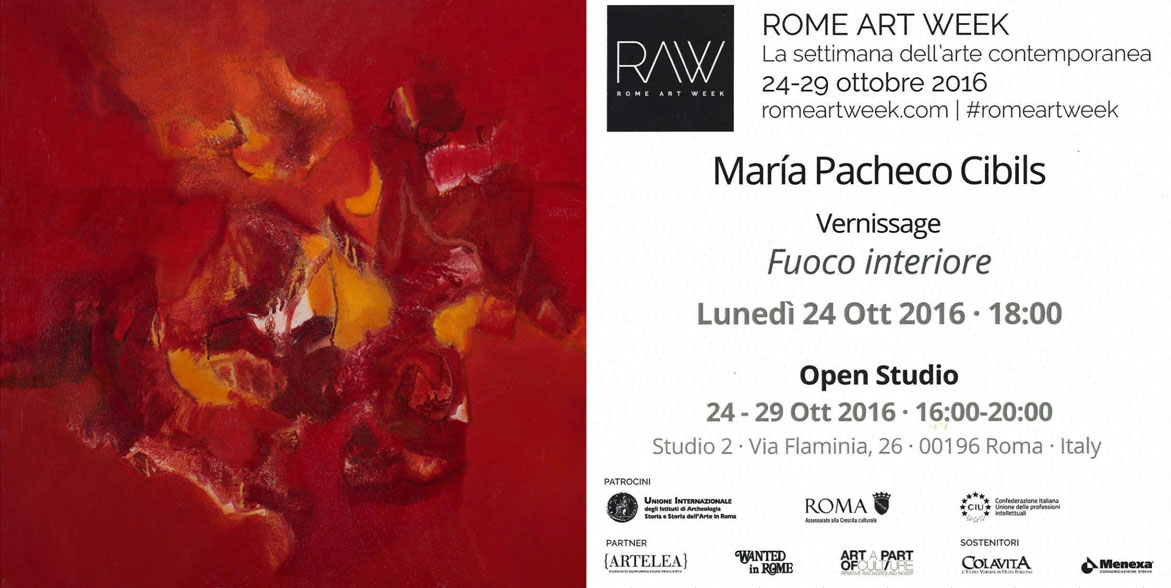
“The real journey of discovery is not to look for new lands but to have new eyes”
Voltaire
Fire: Dry, Hot, Ascending, Moving, Red, Mutant.
This work forms part of a fire, fire as the inner light that activates it creativity.
Painting is the medium as a language of life, matter, and language, as expressive language, bright and poetic.
When entering into a state of silence and observation of the deep, we go through the path that exists there leads to the intimacy of being.
It is here that in total purity and vital energy, which with impetuous force translates into essence, begins to arise, courage, emotion, sensitivity, authenticity, and enlighten the conscience.
An inward and profound journey, which is to all that is latent to awaken and transform, playing with colors, “textures” and lights, discovering new ways and new dimensions

Cultura & Spettacoli
THE COLORS AND CONTRASTS OF “FUEGO INTERIOR” DE MARIA PACHECO CIBILS
An interior fire that transforms into color of strong contrasts and delicate aesthetic search.Maria Pacheco Cibils, Argentine-Portuguese artist, with an Italian soul, with her works has fascinated the visitors of ROME ART WEEK 2016, organized event in the field of events by the “Fuori Quadrienale”, dedicated entirely to Contemporary Art, capturing the attention of experts and the public in generai.
Visions projected by the artist from a personal Universe and then translated into paintings and installations of a strong and intemational character. The last project ofthe same: “Inner Fire”: Passion and strong colors, melancholy an d contrasts, research an d research. The works of Maria pacheco Cibils are wonderful visions that are placed in the panorama of emotion.
They talk about my job

